The Importance of Using a Professional Recruiter to Find and Hire Exceptional Talent in Construction, Engineering, and Environmental Industries
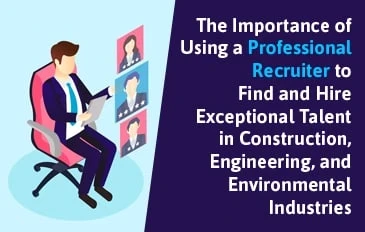
The Importance of Using a Professional Recruiter to Find and Hire Exceptional Talent in Construction, Engineering, and Environmental Industries
In the highly competitive industries of construction, engineering, and environmental sectors, finding and hiring exceptional talent is crucial for success. However, the process of identifying and attracting top-notch candidates can be time-consuming and challenging for organizations. This is where the role of a professional recruiter becomes invaluable.
In this article, we will explore the importance of using a professional recruiter to find and hire exceptional talent in these industries. From their expertise in candidate sourcing and screening to their ability to streamline the hiring process, professional recruiters bring immense value to organizations seeking to build high-performing teams.
- Access to a Vast Network and Industry Knowledge: Professional recruiters have extensive networks and industry knowledge, allowing them to tap into a pool of qualified candidates that might not be readily available through traditional job postings. Their connections and relationships within the industry enable them to identify and reach out to top talent who may not be actively seeking new opportunities. By leveraging their network, recruiters can significantly expand the candidate search and attract highly skilled professionals who are a perfect fit for the specific requirements of the construction, engineering, and environmental industries.
- Expertise in Candidate Screening and Evaluation: Recruiters possess the skills and experience necessary to effectively screen and evaluate candidates. They thoroughly review resumes, assess qualifications, and conduct preliminary interviews to identify the most suitable candidates for the role. Recruiters are adept at identifying not only technical skills but also essential soft skills such as communication, problem-solving, and teamwork, which are crucial in these industries. Their expertise ensures that only the most qualified and competent candidates move forward in the hiring process, saving valuable time and resources for the organization.
- Streamlining the Hiring Process: Hiring exceptional talent requires a well-structured and efficient hiring process. Professional recruiters have the knowledge and tools to streamline the entire process, from creating compelling job descriptions to managing interview schedules and reference checks. They act as a liaison between the organization and the candidates, coordinating interviews, providing timely feedback, and ensuring a smooth candidate experience. By managing the logistics and administrative tasks, recruiters enable the hiring team to focus on evaluating candidates and making informed decisions.
- Confidentiality and Discretion: In certain situations, organizations may need to maintain confidentiality during the hiring process, such as when replacing a key position or expanding into new markets. Professional recruiters understand the importance of discretion and can navigate the hiring process while preserving confidentiality. They can handle sensitive information with utmost care and only disclose information to candidates on a need-to-know basis, ensuring the organization’s reputation and privacy are maintained.
- Negotiating and Securing Top Talent: Recruiters are skilled negotiators who can facilitate the offer process and secure top talent for the organization. They have a deep understanding of industry standards, compensation packages, and market trends. Recruiters can effectively communicate with candidates, address any concerns or questions, and negotiate competitive offers that align with both the candidate’s expectations and the organization’s budget. Their expertise in negotiation ensures a smooth transition from the candidate’s acceptance of the offer to their successful integration into the team.
- Time and Cost Savings: Partnering with a professional recruiter can save organizations significant time and cost in the hiring process. Recruiting professionals have the resources and tools to efficiently attract, screen, and evaluate candidates. By outsourcing the hiring process, organizations can focus on their core business activities while the recruiters handle the time-consuming tasks associated with finding exceptional talent. Additionally, the cost of a bad hire can be detrimental to an organization. Recruiters help mitigate this risk by thoroughly assessing candidates and ensuring they possess the necessary skills and cultural fit,
Michael DeSafey is a leading executive recruiter for professionals in the construction, engineering, and environmental industries. He is currently the President of Webuild Staffing: www.webuildstaffing.com. To learn more about Michael, or to follow his blog, please visit www.michaeldesafey.com.
Category: Construction, Employer Tips, Engineering, Environmental, Recruiting
Fostering Belonging: Building a Sense of Community in the Workplace

Fostering Belonging: Building a Sense of Community in the Workplace
Creating a sense of belonging in the workplace is crucial for employee engagement, satisfaction, and productivity. When individuals feel valued, connected, and included, they are more likely to contribute their best work and thrive in their roles.
In this article, we will explore various strategies and practices to foster a strong sense of belonging in the workplace. By implementing these approaches, organizations can build a supportive and inclusive environment where employees feel like they are part of a cohesive community.
- Cultivate a Welcoming and Inclusive Culture: Develop an organizational culture that values diversity, inclusivity, and respect. Encourage open communication, empathy, and understanding among team members. Promote a zero-tolerance policy for discrimination or harassment. Create employee resource groups or affinity networks that celebrate different backgrounds, interests, and identities. A welcoming and inclusive culture lays the foundation for a sense of belonging to flourish.
- Promote Meaningful Connections: Encourage regular team-building activities, both formal and informal, to foster connections among employees. Organize team lunches, virtual coffee breaks, or social events where colleagues can interact on a personal level. Encourage cross-functional collaboration and provide opportunities for employees to work on projects or initiatives outside their immediate teams. Building strong interpersonal relationships encourages a sense of camaraderie and belonging.
- Foster Collaboration and Communication: Establish a collaborative work environment where individuals feel comfortable sharing ideas, asking for help, and offering support. Implement tools and platforms that facilitate seamless communication and knowledge sharing across teams. Encourage regular team meetings, brainstorming sessions, and feedback exchanges to create a sense of collective contribution and shared goals. Collaboration and open communication strengthen the bonds among team members and enhance their sense of belonging.
- Recognize and Appreciate Contributions: Acknowledge and appreciate the contributions of employees at all levels of the organization. Implement recognition programs that celebrate achievements, milestones, and exceptional performance. Encourage team members to express gratitude and provide peer-to-peer recognition. Recognizing individuals’ efforts and accomplishments fosters a positive work environment and reinforces a sense of value and belonging.
- Provide Opportunities for Growth and Development: Invest in the professional development of employees by offering training programs, mentorship opportunities, and career advancement paths. Provide regular feedback, performance evaluations, and opportunities for skill-building. Employees who feel supported and encouraged in their career growth are more likely to develop a sense of loyalty and belonging to the organization.
- Embrace Employee Voice and Input: Create channels for employees to share their opinions, suggestions, and concerns. Implement employee feedback surveys, suggestion boxes, or regular check-ins. Actively listen to their input and demonstrate that their voices are heard and valued. By involving employees in decision-making processes and incorporating their feedback, organizations empower individuals and foster a sense of ownership and belonging.
- Celebrate Diversity and Foster Inclusion: Embrace and celebrate the diversity of your workforce. Create opportunities to learn about different cultures, traditions, and perspectives. Implement diversity training and workshops to raise awareness and promote inclusive behaviors. Provide resources and accommodations to support employees with diverse needs. By fostering an environment where everyone feels seen, heard, and included, organizations cultivate a strong sense of belonging for all employees.
In conclusion, creating a sense of belonging in the workplace is crucial for employee engagement, satisfaction, and overall organizational success. By cultivating a welcoming and inclusive culture, promoting meaningful connections, fostering collaboration and communication, recognizing contributions, providing growth opportunities, embracing employee voice, and celebrating diversity, organizations can build a strong sense of belonging among their workforce.
Michael DeSafey is a leading executive recruiter for professionals in the construction, engineering, and environmental industries. He is currently the President of Webuild Staffing: www.webuildstaffing.com. To learn more about Michael, or to follow his blog, please visit www.michaeldesafey.com.
Category: Construction, Employer Tips, Engineering, Environmental
7 Effective Ways to Welcome a New Employee to the Team

7 Effective Ways to Welcome a New Employee to the Team
Welcoming a new employee to your team is an important step in creating a positive and supportive work environment. A warm and inclusive onboarding experience not only helps new hires feel valued but also sets the stage for their success within the organization.
In this article, we will explore seven effective ways to welcome a new employee to the team. By implementing these strategies, you can create a welcoming and engaging environment that promotes a smooth transition and fosters strong working relationships.
- Pre-arrival Communication and Preparation: Begin the welcoming process even before the new employee’s first day. Send them a personalized email or welcome package that includes important information such as their start date, dress code, and any required documentation. Ensure that their workspace is clean, organized, and equipped with the necessary tools and supplies. By communicating and preparing in advance, you demonstrate your organization’s attention to detail and dedication to providing a positive onboarding experience.
- Introduce the Team: Arrange a team meeting or virtual introduction to help the new employee get to know their colleagues. Encourage team members to share a bit about themselves, their roles, and their areas of expertise. This introduction helps foster connections and create a sense of belonging from the start. Consider providing the new employee with an organizational chart or team directory to facilitate further networking.
- Assign a Buddy or Mentor: Pair the new employee with a buddy or mentor who can guide them during their initial days. This individual should be a friendly and knowledgeable team member who can answer questions, offer advice, and help the new employee acclimate to the team’s dynamics and culture. The buddy or mentor can provide support, introduce them to key stakeholders, and serve as a go-to resource for any concerns or challenges.
- Provide a Comprehensive Orientation: Conduct a thorough orientation session to familiarize the new employee with the company’s mission, values, policies, and procedures. Cover important information such as IT systems, security protocols, and available resources. Introduce them to key departments, facilities, and support staff. A comprehensive orientation ensures that the new employee understands the organizational structure, sets clear expectations, and feels confident in navigating their new workplace.
- Schedule One-on-One Meetings: Arrange individual meetings between the new employee and key team members, including their supervisor, colleagues from other departments, and key stakeholders. These one-on-one meetings allow for personal introductions, discussions about roles and responsibilities, and the opportunity to clarify expectations. Encourage open communication and provide the new employee with an opportunity to ask questions, seek guidance, and establish professional connections.
- Encourage Team Bonding Activities: Promote team bonding and collaboration by organizing activities outside of regular work hours. This can include team lunches, virtual coffee breaks, or after-work social events. These informal settings provide an opportunity for team members to connect on a personal level, build relationships, and establish a sense of camaraderie. Team bonding activities create a positive and inclusive work environment that supports collaboration and enhances productivity.
- Support Professional Development: Demonstrate your commitment to the new employee’s professional growth by providing opportunities for skill development and career advancement. Discuss their long-term goals and aspirations, and identify areas where they can further develop their skills. Encourage participation in training programs, workshops, or conferences relevant to their role. Offer mentoring or coaching opportunities to support their professional development journey. Supporting their growth not only shows your investment in their success but also enhances their motivation and engagement within the team.
In conclusion, welcoming a new employee to the team sets the tone for their experience within the organization. By implementing these seven strategies, you can create a exception workplace in which employees will thrive in their jobs.
Michael DeSafey is a leading executive recruiter for professionals in the construction, engineering, and environmental industries. He is currently the President of Webuild Staffing: www.webuildstaffing.com. To learn more about Michael, or to follow his blog, please visit www.michaeldesafey.com.
Mastering the Art of Effective Performance Appraisals: A Comprehensive Blueprint
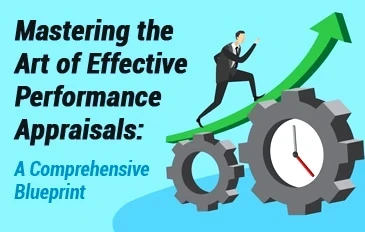
Mastering the Art of Effective Performance Appraisals: A Comprehensive Blueprint
Performance appraisals are a crucial tool for assessing and enhancing employee performance in any organization. When conducted effectively, performance appraisals can inspire employee growth, drive productivity, and foster a culture of continuous improvement.
In this comprehensive article, we will explore the key steps and strategies to conduct an effective performance appraisal process. From goal setting to providing constructive feedback and creating development plans, we will provide actionable tips and insights to help managers and HR professionals master the art of conducting performance appraisals.
- Set Clear Performance Expectations: Establishing clear performance expectations is the foundation of an effective performance appraisal process. Clearly define job responsibilities, key performance indicators (KPIs), and goals in collaboration with employees. Ensure that these expectations are aligned with organizational objectives and provide employees with a clear understanding of what is expected from them. Transparent communication and goal alignment are critical for a successful appraisal process.
- Gather Objective Data: Collecting objective data is essential for conducting fair and accurate performance appraisals. Use a combination of quantitative and qualitative data, including performance metrics, project outcomes, customer feedback, and behavioral observations. Avoid relying solely on subjective opinions or personal biases. Use performance management systems, self-assessments, and feedback from peers and stakeholders to gather a comprehensive view of an employee’s performance.
- Provide Regular Feedback: Regular feedback should be an ongoing process rather than a once-a-year event. Establish a culture of continuous feedback where managers provide constructive input and guidance throughout the year. Timely feedback allows employees to make necessary improvements and align their performance with expectations. Incorporate both positive reinforcement and areas for development in your feedback, focusing on specific behaviors and outcomes.
- Conduct a Structured Performance Review Meeting: The performance review meeting is a critical component of the appraisal process. Prepare for the meeting by reviewing the employee’s performance data, feedback, and self-assessment. Create a structured agenda that covers the employee’s achievements, strengths, areas for improvement, and development opportunities. Encourage open and honest dialogue, allowing employees to share their perspectives and aspirations. Use active listening techniques to understand their viewpoints and address any concerns.
- Focus on Strengths and Areas for Improvement: During the performance appraisal, strike a balance between recognizing an employee’s strengths and identifying areas for improvement. Celebrate their accomplishments and contributions to boost morale and motivation. Discuss areas where improvement is needed, providing specific examples and actionable suggestions. Collaboratively set performance improvement goals that are challenging yet attainable.
- Develop Personalized Development Plans: A performance appraisal should serve as a foundation for employee development. Work together with the employee to create a personalized development plan that outlines actionable steps for enhancing skills and addressing development needs. Provide resources, training opportunities, and mentorship to support their growth. Regularly revisit the development plan and track progress during follow-up discussions.
- Document Performance Appraisal Results: Maintain accurate and thorough documentation of the performance appraisal process. Document the performance review meeting, including key discussion points, agreed-upon goals, and development plans. Keep a record of performance data, feedback, and any other relevant information. Documentation serves as a reference for future appraisals, performance discussions, promotions, and compensation decisions.
- Follow-Up and Follow Through: Ensure that the performance appraisal process does not end with the review meeting. Schedule follow-up meetings or check-ins to track progress on goals and development plans. Provide ongoing support, guidance, and coaching to help employees succeed. Encourage open communication and address any challenges or roadblocks along the way. Regular follow-through demonstrates commitment to employee growth and reinforces the importance of performance
Michael DeSafey is a leading executive recruiter for professionals in the construction, engineering, and environmental industries. He is currently the President of Webuild Staffing: www.webuildstaffing.com. To learn more about Michael, or to follow his blog, please visit www.michaeldesafey.com.
Category: Construction, Employer Tips, Engineering, Environmental
The Essential Role of Offboarding: Why It’s as Vital as Onboarding

The Essential Role of Offboarding: Why It's as Vital as Onboarding
When it comes to the employee lifecycle, organizations often prioritize the onboarding process to ensure a smooth transition for new hires. However, many overlook the significance of a well-executed offboarding process. Offboarding refers to the formal process of transitioning employees out of an organization when they leave, whether due to resignation, retirement, or termination
. In this blog post, we will explore the importance of offboarding and why it should be considered as crucial as onboarding. From maintaining positive employer branding to preserving institutional knowledge, we will discuss the benefits of a comprehensive offboarding strategy.
- Preserving Institutional Knowledge: Offboarding plays a critical role in preserving institutional knowledge within an organization. When employees depart, they take with them valuable insights, experiences, and expertise that may be crucial to the organization’s success. A well-structured offboarding process ensures that departing employees have the opportunity to share their knowledge with their successors and document important information. By capturing and transferring institutional knowledge, organizations can minimize the loss of critical information and maintain continuity in operations.
- Fostering Positive Employer Branding: Offboarding presents an opportunity to leave a lasting impression on departing employees, which can significantly impact an organization’s employer branding. How employees are treated during their exit can influence their perception of the company and the way they speak about it to others. A positive offboarding experience, involving respectful and supportive treatment, can contribute to a positive employer reputation and generate goodwill among former employees. This, in turn, can lead to positive word-of-mouth referrals, potential boomerang hires, and enhanced brand perception in the job market.
- Managing Security and Data Protection: Offboarding is crucial for ensuring the security and protection of sensitive company data. Employees who leave an organization should undergo a thorough process to revoke their access to company systems, databases, and confidential information. This includes deactivating accounts, collecting company-owned devices, and ensuring that employees return or securely dispose of any confidential materials. A robust offboarding procedure minimizes the risk of data breaches, unauthorized access, and intellectual property theft, safeguarding the organization’s reputation and compliance with data protection regulations.
- Nurturing Alumni Networks and Relationships: Effective offboarding can help organizations maintain strong connections with former employees, nurturing an active and engaged alumni network. These networks can be a valuable resource for talent acquisition, industry insights, and even potential business opportunities. By maintaining relationships with alumni, organizations can tap into their expertise, seek referrals, and create a network of brand advocates who can speak positively about their experiences with the company. Regular communication, alumni events, and networking opportunities can strengthen these relationships and contribute to long-term organizational success.
- Enhancing Employee Experience and Engagement: Offboarding experiences can shape employees’ perceptions of their overall employee journey, impacting their engagement and loyalty during their tenure. A well-planned offboarding process demonstrates that the organization values and respects its employees, even when they are leaving. Providing support, conducting exit interviews, and addressing any concerns can contribute to a positive experience and help departing employees feel heard and valued. This positive offboarding experience can leave a lasting impression and potentially lead to positive recommendations and referrals.
- Compliance with Legal and Regulatory Obligations: Offboarding is crucial for ensuring compliance with legal and regulatory obligations related to employee exits. It involves conducting necessary documentation, such as exit interviews, separation agreements, and final paychecks, in accordance with employment laws and regulations. A thorough offboarding process ensures that all legal obligations, including tax and benefit-related requirements, are fulfilled, mitigating the risk of potential legal disputes. Compliance with these obligations demonstrates the organization’s commitment to ensuring an past employees success in moving on to new employment.
Michael DeSafey is a leading executive recruiter for professionals in the construction, engineering, and environmental industries. He is currently the President of Webuild Staffing: www.webuildstaffing.com. To learn more about Michael, or to follow his blog, please visit www.michaeldesafey.com.
Category: Employer Tips
Unleashing the Potential: The Productivity of Millennials in the Construction Workforce
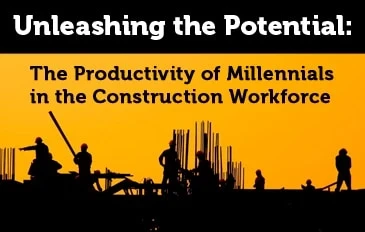
Unleashing the Potential: The Productivity of Millennials in the Construction Workforce
The construction industry is witnessing a new generation taking the reins – the millennials. As this tech-savvy and ambitious group enters the workforce, it’s essential to examine their impact on productivity in the construction industry. This blog post aims to explore the unique characteristics, strengths, and contributions of millennials in the construction workforce, dispelling common misconceptions and shedding light on the value they bring to the table.
- Embracing Technology and Innovation: Millennials grew up in the digital age, making them natural adopters of technology. Their tech-savviness brings a fresh perspective to the construction industry, driving innovation and efficiency. From using advanced project management software to leveraging mobile apps for on-site collaboration, millennials embrace digital tools that streamline processes and enhance productivity.
- Collaboration and Teamwork: Millennials thrive in collaborative environments and value teamwork. They grew up in an era that emphasized group projects, teamwork, and open communication. In the construction industry, their inclination toward collaboration fosters better communication, efficient problem-solving, and the ability to adapt to rapidly changing project dynamics. Millennials excel in cross-functional teams, leveraging their strengths to achieve project objectives.
- Embracing Sustainable Practices: Millennials have a strong awareness of environmental sustainability and social responsibility. They prioritize green practices and seek out employers who share these values. In the construction industry, their commitment to sustainability drives the adoption of eco-friendly materials, energy-efficient technologies, and environmentally conscious construction methods. This focus on sustainable practices not only aligns with the industry’s evolving needs but also enhances productivity by reducing waste and optimizing resource allocation.
- Desire for Career Development: Millennials are ambitious and have a strong desire for career growth and development. They value continuous learning and seek opportunities to acquire new skills. In the construction industry, their drive for professional development translates into increased productivity. Millennials actively seek out mentors, training programs, and opportunities to expand their knowledge and expertise. Their hunger for growth fuels their commitment to mastering their craft, which ultimately benefits project outcomes.
- Flexibility and Adaptability: Millennials are known for their adaptability and flexibility. They are comfortable with change and can quickly adapt to new technologies, methodologies, and work environments. In the construction industry, where project requirements and timelines can evolve rapidly, millennials excel at embracing change and finding creative solutions. Their ability to adapt to new challenges and leverage emerging technologies positively impacts productivity by enabling quick decision-making and agile project management.
- Embracing Diversity and Inclusion: Millennials value diversity and inclusion in the workplace. They appreciate diverse perspectives and actively seek out inclusive work environments. In the construction industry, their embrace of diversity fosters innovation, collaboration, and improved problem-solving. By promoting a culture of inclusivity, millennials contribute to higher employee engagement and productivity by creating a sense of belonging and leveraging the collective wisdom of diverse teams.
In conclusion, as millennials enter the construction workforce, their unique characteristics and strengths contribute to increased productivity and innovation. Their proficiency with technology, collaborative mindset, commitment to sustainability, thirst for career development, adaptability, and embrace of diversity all shape a new era in the construction industry. By recognizing and leveraging the productivity of millennials, construction companies can create an environment that embraces change, fosters innovation, and delivers exceptional project outcomes. The construction industry stands to benefit greatly from the fresh perspectives and contributions of this dynamic generation.
Michael DeSafey is a leading executive recruiter for professionals in the construction, engineering, and environmental industries. He is currently the President of Webuild Staffing: www.webuildstaffing.com. To learn more about Michael, or to follow his blog, please visit www.michaeldesafey.com.
Unleashing Potential: The Strength-Based Approach to Talent Development
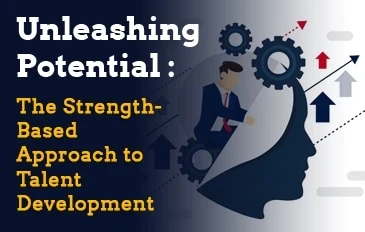
Unleashing Potential: The Strength-Based Approach to Talent Development
In the world of talent development, a paradigm shift has occurred. Traditional approaches often focused on identifying and fixing weaknesses, but today, a strength-based approach is gaining momentum. This blog post aims to explore the power and benefits of adopting a strength-based approach to talent development. We will delve into the principles, strategies, and impacts of leveraging individual strengths to unlock untapped potential, enhance employee engagement, and drive organizational success.
- Understanding the Strength-Based Approach: The strength-based approach centers on identifying and cultivating individuals’ unique strengths and talents. Instead of solely focusing on weaknesses or skill gaps, this approach emphasizes harnessing and leveraging existing strengths to achieve excellence. It acknowledges that each individual possesses a set of natural talents and abilities that, when nurtured, can lead to exceptional performance and fulfillment.
- Identifying Individual Strengths: Discovering individual strengths is a critical first step in the strength-based approach. Various methods, such as assessments, interviews, and self-reflection exercises, can help individuals recognize their innate talents. Tools like the CliftonStrengths assessment or VIA Character Strengths survey provide valuable insights into one’s top strengths, enabling individuals and organizations to align roles and responsibilities with these inherent capabilities.
- Cultivating Strengths in the Workplace: Once strengths are identified, organizations can create an environment that fosters the development and application of these strengths. This can be achieved through targeted training programs, coaching, and mentoring initiatives. Opportunities for employees to apply their strengths in meaningful ways, such as assigning tasks that align with their strengths or creating cross-functional teams that leverage diverse strengths, can significantly enhance engagement and productivity.
- Benefits of a Strength-Based Approach: The strength-based approach brings numerous benefits to both individuals and organizations. For individuals, it boosts self-awareness, confidence, and motivation, allowing them to excel in their areas of strength. It promotes a positive mindset and a sense of fulfillment, leading to increased job satisfaction and overall well-being. Organizations benefit from higher employee engagement, increased productivity, and improved team dynamics. Leveraging strengths enhances collaboration, as individuals bring complementary skills to achieve collective goals.
- Leadership and the Strength-Based Approach: Leaders play a crucial role in implementing the strength-based approach. They can create a culture that values and recognizes individual strengths, inspiring others to do the same. Effective leaders invest time in understanding their team members’ strengths and aligning tasks and projects accordingly. They provide opportunities for growth and development that capitalize on strengths, fostering an environment of continuous improvement and innovation.
- Overcoming Challenges and Potential Pitfalls: While the strength-based approach is powerful, challenges may arise during implementation. It is important to avoid neglecting areas of improvement entirely, as a balanced approach is essential. Additionally, overcoming potential biases and stereotypes is crucial, ensuring equal opportunities for all employees to showcase their strengths. Regular feedback and coaching are necessary to provide support and help individuals maximize their strengths while addressing any performance gaps.
In conclusion, embracing a strength-based approach to talent development can unlock untapped potential, enhance engagement, and drive exceptional performance. By recognizing and cultivating individual strengths, organizations foster a culture of empowerment and fulfillment. Leaders who embrace this approach create environments where employees thrive, leading to higher productivity and innovation. As the strength-based approach continues to gain recognition, it is clear that focusing on strengths is a game-changer in talent development, enabling individuals and organizations to reach new heights of success.
Michael DeSafey is a leading executive recruiter for professionals in the construction, engineering, and environmental industries. He is currently the President of Webuild Staffing: www.webuildstaffing.com. To learn more about Michael, or to follow his blog, please visit www.michaeldesafey.com.
Category: Career Training, Construction, Employer Tips, Engineering, Environmental
Boss vs. Leader: Unveiling the Distinction in Construction and Engineering Businesses
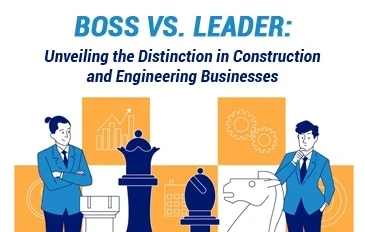
Boss vs. Leader: Unveiling the Distinction in Construction and Engineering Businesses
In the construction and engineering industries, effective leadership is paramount to success. However, being a boss and being a leader are not interchangeable terms. This blog post aims to explore the fundamental differences between being a boss and being a leader within the context of construction and engineering businesses. We will delve into the qualities, approaches, and impacts of both roles to understand how they shape organizational culture, employee engagement, and overall project outcomes.
- Authority vs. Influence: A boss typically relies on their position of authority to exercise control and demand compliance. They use their formal power to make decisions, assign tasks, and enforce regulations. In contrast, a leader focuses on influence rather than authority. They earn the respect and trust of their team through their expertise, communication skills, and ability to inspire. Leaders lead by example and motivate their team members to achieve their best.
- Transactional vs. Transformational: A boss tends to employ a transactional leadership style, which centers around rewarding or punishing employees based on performance. They focus on meeting specific targets and enforcing rules to maintain discipline. On the other hand, a leader adopts a transformational leadership style, inspiring and empowering their team members to grow, innovate, and excel. They foster a collaborative environment that encourages personal and professional development.
- Task-Oriented vs. People-Oriented: Bosses are typically task-oriented, prioritizing productivity and efficiency. They may overlook the individual needs, motivations, and well-being of their team members. Leaders, on the other hand, are people-oriented. They invest time and effort in understanding their employees, providing guidance, mentorship, and support. Leaders value the unique strengths of their team members and align their roles with individual capabilities for optimal performance.
- Short-Term vs. Long-Term Focus: A boss often focuses on short-term goals and immediate results. Their decision-making revolves around meeting deadlines and achieving immediate objectives, sometimes overlooking the long-term consequences. In contrast, leaders take a more strategic approach, considering the long-term impact of their decisions. They envision the future, set clear goals, and inspire their team to work towards a shared vision of success.
- Control vs. Empowerment: Bosses typically maintain tight control over their team members, dictating the how, when, and what of tasks. They have a top-down approach, stifling creativity and autonomy. Conversely, leaders believe in empowering their team members. They delegate responsibilities, encourage innovation, and trust their employees to make informed decisions. Leaders create an environment that fosters ownership, collaboration, and continuous improvement.
- Impact on Organizational Culture: The leadership style employed within construction and engineering businesses significantly impacts the organizational culture. A boss-driven culture may breed fear, resentment, and disengagement among employees. It can result in high turnover rates and limited employee loyalty. In contrast, a leader-driven culture fosters trust, open communication, and a sense of belonging. It encourages employee growth, job satisfaction, and loyalty, ultimately leading to increased productivity and innovation.
In conclusion: the construction and engineering industries, being a boss is not synonymous with being a leader. While a boss relies on authority and transactional relationships, a leader inspires through influence and transformation. The distinction between the two lies in their approaches to authority, communication, employee empowerment, and long-term vision. By embracing leadership qualities and adopting a transformational style, construction and engineering professionals can create an environment that fosters growth, collaboration, and exceptional project outcomes.
Michael DeSafey is a leading executive recruiter for professionals in the construction, engineering, and environmental industries. He is currently the President of Webuild Staffing: www.webuildstaffing.com. To learn more about Michael, or to follow his blog, please visit www.michaeldesafey.com.
Category: Career Training, Construction, Employer Tips, Jobs, Recruiting
Tips for Hiring New Graduates who will Succeed in Your Organization

Tips for Hiring New Graduates who will Succeed in Your Organization
The construction, engineering, and environmental industry is a great place for new graduates to start their careers. It’s a challenging and rewarding field that offers growth opportunities. However, it can also be challenging for new graduates to break into this industry. That’s why we’ve put together some tips to help you find and hire the best new graduates for your organization.
1) Use Social Media to Your Advantage
Social media is a great way to connect with potential graduate candidates. Use it to post job openings and reach out to new graduates who might be interested in working for your organization.
LinkedIn is a great platform to use when hiring college graduates. Many construction, engineering and environmental professionals are active on LinkedIn, so it’s a great way to connect with potential candidates.
When creating your job posting, include information about your company culture and what makes your organization a great place to work. This will help attract top talent to your company. Include a link to your company website in your job postings so that candidates can learn more about your organization.
Ensure that you’re clear about the qualifications and skills you are looking for in a candidate. This will help you weed out candidates who are not a good fit for your organization.
Be prepared to answer any questions candidates may have about the job or your company. Candidates will want to know what they can expect if hired, so be sure to have this information ready.
Be flexible with your start dates. Many new graduates will already have other commitments to juggle, such as school or other jobs. If you can be flexible with their start date, candidates will find it easier to accept your offer of employment.
2) Network with New Graduates
Attend job fairs and career fairs at local colleges and universities. This is a great way to meet potential candidates and learn about their skills and qualifications. Make sure you have business cards available, or some other way for candidates to contact you after the event.
Follow up with any promising candidates that you meet at these events—send them an email or give them a call to gauge their level of interest in working for your organization. If you know any new graduates looking for a job, reach out to them and see if they might be interested in working for your company.
3) Give Candidates a Chance to Shine
When interviewing college candidates, allow them to show off their skills and qualifications. Ask them questions about their experience and education. If you have any projects that new employees could work on, consider assigning them to these projects during the interview process. This will allow candidates to show you what they’re capable of and how they could be an asset to your organization.
After the interview, follow up with candidates to let them know you appreciate their time and their interest in working for your company.
4) Be Clear About Your Expectations
When hiring new graduates, set realistic expectations for their first few months on the job. Let them know what you expect from them regarding work hours and workload. Make sure they understand your company’s policies and procedures. Give them a chance to ask questions about their job, and answer any questions they might have about your expectations regarding their performance.
5) Offer a Competitive Salary and Benefits Package
When offering a job to a new graduate, be sure to offer a competitive salary and benefits package. Many new college graduates are looking for jobs that offer good pay and benefits. A competitive salary and benefits package will help you attract the best candidates to your company.
Be prepared to negotiate on salary and benefits if necessary. Many new graduates are willing to negotiate on these items to get the job they want.
6) Be Patient
Many new graduates need some time to adjust to the workforce. They may make mistakes at first, or have difficulty with some of their job responsibilities. Be patient with new employees—give them a chance to learn, grow into their positions and to improve their skills / knowledge over time.
Hiring new graduates can be a great way to bring fresh talent into your business. By following these tips, you’ll give your new hires the best chance to succeed in their new roles. If you offer them a bit of time and support, they’ll soon reward you with significant contributions to your company.
Michael DeSafey is a leading executive recruiter for professionals in the construction, engineering, and environmental industries. He is currently the President of Webuild Staffing: www.webuildstaffing.com. To learn more about Michael, or to follow his blog, please visit www.michaeldesafey.com.
Category: Construction, Employer Tips, Engineering, Environmental, Jobs, Recruiting
Use Your Gut to Find, Retain, and Let Go of Talent

Use Your Gut to Find, Retain, and Let Go of Talent
In recent years, the demand for skilled labor in the construction, engineering, and environmental industries has far outstripped supply. With an ever-growing skills shortage and the rapid changes in what workers need to know to be successful, it’s more important than ever to use your gut when hiring new employees. The most successful organizations can identify and attract top talent, even in a competitive market.
To find and retain the best employees, employers need to be aware of the changing needs of the workforce and be willing to invest in their development. With the right team in place, any organization can reach its full potential.
As any successful business owner knows, hiring the right employees is essential to the long-term success of any company. However, identifying the right talent is only half the battle: it’s also important to know when to let go of employees who are no longer a good fit for your company. There are several signs that an employee may no longer be a good fit, such as consistently poor performance, difficulty getting along with others, or a toxic attitude. If left unchecked, these problems can have a negative impact on morale and productivity. While it can be difficult to let go of an employee, it’s often necessary to do so in order to maintain a healthy and productive work environment.
War for Talent
The “War for Talent” refers to the ongoing battle to attract and retain the best construction, engineering, and environmental workers. In light of the ever-growing skills shortages in these fields, it’s more important than ever to use your gut when hiring new employees. This means looking beyond qualifications and experience alone, and focusing on finding people who’ll be a good fit with your company culture. With the right team in place, you’ll be able to weather any storm and come out on top in terms of talent retention. So don’t be afraid to take a chance on that new hire—they might just be the one you’ve been looking for.
As any successful business owner knows, having the right team in place is essential to success. That means not only being able to identify the right talent when you see it, but also knowing when to let go of employees who are no longer a good fit for your company. Of course, making such decisions is never easy, but it’s important to remember that letting go of an underperforming employee can be just as important as hiring a top performer. After all, every member of your team has an impact on your company’s culture and bottom line. So if you find yourself with an employee who is no longer meeting your expectations, don’t be afraid to make a change. It may be just what your business needs to reach the next level.
Hiring New Employees
One way to make sure you’re making the best hiring decision is to use your gut. That means being able to identify the right talent when you see it. Of course, you’ll want to review resumes and conduct interviews, but it’s also important to trust your instincts. If you feel a candidate has the right skills and personality for the job, chances are that they do. Using your gut is one of the best ways to ensure that you hire the right person for the job.
Top Skills Employers Look for in New Hires
When it comes to hiring new employees, employers are looking for workers with the following skills:
- Communication: Workers need to communicate effectively during construction projects, which often involve many people and moving parts.
- Problem-solving: The ability to identify and solve problems is valuable in any industry, but it’s especially important in construction, engineering, and environmental work.
- Collaboration: Again, while working well with others is a key skill in any industry, it’s particularly crucial in construction, engineering, and environmental work.
- Creativity: Construction, engineering, and environmental work often involve problem-solving, meaning that workers in these fields need to be creative.
- Leadership: The ability to lead is a valuable skill in any industry, but especially in construction, engineering, and environmental work.
- Why Use Your Gut when Hiring New Employees?
- There are several reasons why you should use your gut when hiring new employees:
- You can’t always rely on resumes. A resume can tell you a lot about a person, but it can’t always give you the whole picture.
- You need to be able to identify the right talent when you see it. With an ever-growing skills shortage, it’s more important than ever to identify the right talent when it crosses your path.
- You need to know when to let go of employees who are no longer a good fit. The things workers need to know to be successful will change over time, so it’s important to know when to let go of employees who are no longer a good fit for your company.
The War for Talent is an ongoing battle to attract and retain the best construction, engineering, and environmental workers. As skills shortages grow ever more dire, it’s becoming increasingly important to use your gut when hiring new employees. This will not only give you a good employment record, but will also increase your talent retention.
Michael DeSafey is a leading executive recruiter for professionals in the construction, engineering, and environmental industries. He is currently the President of Webuild Staffing: www.webuildstaffing.com. To learn more about Michael, or to follow his blog, please visit www.michaeldesafey.com.
Category: Construction, Employer Tips, Engineering, Environmental, Jobs, Recruiting
Red Flags for Bad Hires! Nine Key Signs You’ve Hired the Wrong Person
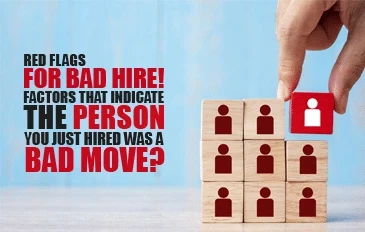
Red Flags for Bad Hires! Nine Key Signs You've Hired the Wrong Person.
If you’re regularly interviewing job candidates, there’s no way around it: from time to time, you’ll make a bad hiring decision. Sometimes, it’s not until after they’ve been on the job for a while that you realize they’re not a good fit for the position. If you observe the following red flags, it may be time to start reflecting on whether they deserve another chance, or whether it’s time to let them go.
Bad Attitude
A bad attitude is one of the most significant red flags when it comes to evaluating your employees. No matter how seasoned, skilled, or stable the candidate might seem, someone with a bad attitude will not be able to hold their own in the workplace.
Poor Organization
A poorly organized employee will not be able to keep up with the work required. If they don’t maintain a current list of their files, for example, they might not even know if they have the correct files on hand. This will affect their work performance (as well as reflect poorly on your hiring skills). File organizing is even more important in engineering and IT because these fields rely on an up-to-date and functional file system. Bad organization on the part of an employee can lead to countless problems, so it’s vital to hire someone who can stay organized.
Punctuality
One of the essential attributes of any potential employee is their availability during working hours. Consider a candidate who looked good on paper, but can’t meet one of the most basic expectations laid out in their employment contract, namely showing up on time in the morning. Employees like these are clearly showing you that they don’t understand the requirements of the job or ignoring them; if you keep them on, you have nobody but yourself to blame.
Dismissed Feedback
Any employee who’s interested in improving their job performance will value good feedback. If a candidate refuses to accept feedback, that’s another sign that they may not be the best hire for you. This is particularly relevant when the feedback you provide is backed up by observations of their workplace behavior.
Inconsistent Communication
If a job candidate is constantly missing deadlines for submitting reports or making contact with you, this may leave you wondering whether they’re up to the task of being your employee. A number of factors can cause these inconsistencies, but it’s important to note that someone who’s easily distracted (and will therefore be likely to miss deadlines) may not be the best person for the role. Construction work, graphic design, and many other jobs require ultra-dedicated workers, so consistency is a must.
Numerous Mistakes
One critical aspect of any job is ensuring that your employees are doing what they’re supposed to do. If an employee has mistakenly performed tasks outside their job description, this can be a huge indicator that you’re about to have a bad time in the workplace. An employee who’s consistently underinformed or confused will cause problems that take valuable time and resources to fix—it’s always better to hire someone who is willing and able to do their job correctly.
Compromising Quality
If an employee lacks the ability to work to the standards your business requires, you will again be forced to put in more valuable time and effort to fix their mistakes. If you’re lucky enough to realize this early on, firing them before they do too much damage is the best option.
Lack of Commitment
This is another huge red flag. If an applicant doesn’t seem fully committed to the job you’re offering them, they may be a bad hire. Someone who struggles to stay interested in your company or position is unlikely to be a good employee. Working in an environmental field requires commitment, so if someone cannot commit to the job, be aware that they may not be a good fit.
Signs of Losing Interest
If a job candidate starts showing signs that they’re losing interest in the role, this may be a serious indication that they’ve already decided that your company is not for them. A bored employee can cause significant problems in the workplace. If an employee is struggling to get excited about their job, there may be negative consequences for your business.
Michael DeSafey is a leading executive recruiter for professionals in the construction, engineering, and environmental industries. He is currently the President of Webuild Staffing: www.webuildstaffing.com. To learn more about Michael, or to follow his blog, please visit www.michaeldesafey.com.
Category: Construction, Employer Tips, Engineering, Environmental, Recruiting
How to Strengthen Your Organization By Hiring Talent

How to Strengthen Your Organization By Hiring Talent
If you are looking to hire talent that performs well in the construction or engineering industry, you want to make sure you are not limiting yourself in the way you think about recruitment. Improving your recruitment strategy can help upgrade the level of talent that you are attracting and hiring. WeBuild Staffing is considered one of the nation’s leading staffing agencies and is dedicated to scouting high quality, industry-specific technical professionals. We are committed to finding exceptional employees, and you should be too. Do you think your recruitment strategy might be flawed? Here are some Dos and Don’ts that might help you identify issues.
Don’t…
Rely Too Much On The Interview
Interviews are essential to landing a job, but they not everything. The person you are interviewing could be having a bad day or display uncharacteristic anxious. Some people will also say anything to secure a job, and great social skills and interview performance do not guarantee they are the most qualified for the job. This is especially important in the construction and engineering industries, where the new hire will be performing specific and specialized tasks.
Do…
Make sure you consider the application as a whole, taking into account the candidate’s experience and any projects they have done, without letting yourself be blinded by the way —good or bad— in which they present themselves.
Don’t…
Feel Threatened by Someone More Qualified Than You
In fear that they might jeopardize their position, managers are often hesitant to take on someone with better skills or who seem more talented. However, this person could become a vital asset and improve your company.
Do…
Look at special certifications or skills that a candidate will bring that are not already available at your company. There is no such thing as being overqualified for the job!
Don’t…
Let the Job Description Misrepresent the Job
The term itself could be misleading; a good job description is in fact more than just a description. You cannot simply offer an overview of the job, and even a long explanation might be too broad, leaving your new employees to be caught off guard by some of the duties they are asked to perform.
Do…
Include a list of duties as part of the job specifications. Make sure you indicate exactly what skills and requirements are needed to attract the right talent and discourage unqualified individuals from applying. Put yourself in the shoes of someone looking for a job: wouldn’t you want to know exactly what will be expected of you?
Don’t…
Wait For The Perfect Candidate
Most employers want to find people who check every box. However, it is time-consuming and nearly impossible to find the perfect fit for every position. The longer you wait for a candidate who is exactly what you pictured, the more you are jeopardizing your team.
Do…
Keep an open mind about what you are looking for, and consider giving a chance to someone who shows potential and is eager to grow and learn. They can end up being a valuable team member.
Don’t…
Overthink References
While references are a key part of the hiring process and give an insight into whether a candidate is a good fit for the job, they are not everything. Job seekers are very likely to have gathered their references from people they knew would give them a positive review —often close friends as well as employers— and a good experience at one company doesn’t mean it will be the same for yours.
Do…
Use references as one element for consideration in the comprehensive process of forming your own judgement about the value a candidate can bring to your company.
Michael DeSafey is a leading executive recruiter for professionals in the construction, engineering and environmental industries. He is currently the President of Webuild Staffing www.webuildstaffing.com . To learn more about Michael or to follow his blog please visit www.michaeldesafey.com
How to Hire Smart People Who Will Advise Us What to Do

How to Hire Smart People Who Will Advise Us What to Do
As a leader in the construction, engineering, or environmental space, you probably know that people are the organization’s most significant assets and capital. In essence, your hiring process could be the difference between success and failure of your company. How, then, can you hire smart people who will have the right expertise and insights to advise you on what to do? Here are essential tips that will help you get smart, proactive, and innovative staff for your firm.
Use a Talent Philosophy
When hiring, seek out individuals who are smarter, better, and more talented than you. It is also essential to look for independent-minded people who won’t fear sharing divergent opinions from yours. Avoid “yes men” employees who lack innovative ideas. The right candidate should have the knowledge and courage to identify and point out any errors you might make and suggest alternative solutions.
Keep Up to Date With Market Trends
Getting the smartest talent takes more than flipping through candidates’ resumes. Take the time to research the best-recruiting companies and the recruitment strategies they use to net highly skilled and talented employees. You also need to understand the ever-changing job market landscape. Talent keeps evolving and what worked well in the past may not be relevant for current job needs. Where possible, work with experienced recruitment agencies to help you quickly identify the best candidates. You can also ask your existing team to refer skilled candidates for consideration who fit your company’s standards.
Leverage on Social Media and Digital Trends
Social media is another great way to attract and retain the right talent. Using Facebook, LinkedIn, or Instagram appropriately, you can create a profile or embed your own digital culture site to show both what you can offer and what you are looking for in an employee. Make sure your page or website is mobile-friendly; up to 58% of potential employees use their smartphone when hunting for a job. Find out more about interesting candidates by looking at their online profiles and activities; you can mine critical data on an individual with a straightforward social media background check. Although not necessarily a decisive recruiting factor, social media activity will give you an idea of the candidate’s professional and personal interests, and make the screening process simple and effective.
Set Up a Stringent Hiring Process
However urgent your recruiting needs may be, avoid the urge to rush to hire. Use a failsafe hiring process to help you identify ideal skills and talent as quickly as possible while still being thorough. This involves formulating a comprehensive list of relevant questions and establishing a grading process that will enable a tight recruitment process. If you need help, delegate this to a solid hiring specialist or team who will shortlist candidates and conduct interviews. You can also set up a multi-tier interview process if you have a large pool of talented candidates to choose from. Finally, as a manager, hiring the ideal personnel is one of your most essential responsibilities. Look for candidates who bring in opportunities to grow your department and organization.
Michael DeSafey is a leading executive recruiter for professionals in the construction, engineering and environmental industries. He is currently the President of Webuild Staffing www.webuildstaffing.com . To learn more about Michael or to follow his blog please visit www.michaeldesafey.com
How Performance Reviews Build Strong Workers in Your Company
How Performance Reviews Build Strong Workers in Your Company

You might think that employee reviews are simply about evaluating a worker’s performance. But they are even more valuable as a way to develop and retain good workers.
Anthony Fasano, PE and author of Engineering Your Own Success, developed an engineering.com blog and podcast on the subject. Fasano says that performance reviews are critical to both companies and employees because having goals and expectations in sync is what builds success for all parties.
In an article at For Construction Pros.com, Brad Humphrey (also known as The Contractor’s Best Friend) agrees.
“Most good workers, even those who can slip occasionally, want their performance to be assessed and discussed,” Humphrey wrote. “They welcome this opportunity and the accountability that can come with it. It’s only the lazy and contrary workers who breathe easier if they can live without any accountability.”
So if your goal is to retain good workers in the construction, engineering or environmental fields and to minimize the challenge of a labor shortage in the workforce, then performance reviews are a critical tool.
Reasons to conduct performance reviews
- Employees want to know how they’re doing in their roles and responsibilities as compared to their contractor’s or manager’s expectations.
- Contractors and supervisors want to assess how well their onboarding and skills training is working for new employees, and to reinforce positive work habits for existing employees.
- Aligning goals and expectations benefits both parties.
What to include in the performance review
- Specific major projects or initiatives completed since the last review
- Technical and job-related skills and knowledge
- Interaction with co-workers, supervisors, contractors, clients or vendors
- Problem-solving skills
- Attitude and effort on the job
- Attendance
- General company policies and procedures
How to conduct an effective performance review
- The format of the review isn’t important, as long as it’s easy for both the person completing the review and the person receiving it to understand. Templates are available online if you need them.
- Employees should do a self-evaluation, preferably that matches the employer’s version, so that they can compare and discuss areas where they disagree.
- Contractors should review new workers at 30, 60 and 90 days so that these new employees stay on track, engaged in training requirements and proficiency standards, and are prepared for future annual reviews.
- Regardless of how long employees have been with a group, they should get an annual performance review. This is an opportunity to recognize and appreciate your long-term employee’s contributions and to set continuing goals that will help them stay committed.
- Use specific examples of an employee’s work practices and behavior. Provide both positive observations and areas that need improvement. Encourage questions and discussion so that everyone is clear on what you want to see continued and what needs to change.
- Be specific on any requirements not met or areas that are not as strong as earlier reviews.
- If a review will be mostly negative, consider having two leaders attend the discussion.
- If a review will be mostly positive, don’t skip it. Your best workers are probably goal setters who want to discuss next steps and action plans. Keep them engaged and committed to the company, and be sure they know they are valued and appreciated.
- Include proactive goal setting in every review. Define what actions the employee will take in the next year, what support their contractor or manager will provide, and what resources are needed.
- Conclude all reviews, whether positive or negative, with encouragement and appreciation. Knowing that a contractor or boss wants them to do well and is there to support them is important to employee satisfaction and retention.
It may be time-consuming to conduct an annual review with each worker, but it’s critical to keeping your best employees, to correcting potential issues before they become major problems, and to developing good workers in your crew.
If you need help to build your crew in the construction, engineering or environmental field, WeBuild Staffing can help. WeBuild specializes in recruitment of professional within the construction, engineering and environmental industries. Please contact us for more information.
Michael DeSafey is a leading executive recruiter for professionals in the construction, engineering and environmental industries. He is currently the President of Webuild Staffing www.webuildstaffing.com . To learn more about Michael or to follow his blog please visit www.michaeldesafey.com
Category: Employer Tips
Teamwork in Recruiting Build a Hiring Dream Team

Teamwork in Recruiting — Build a Hiring Dream Team
Recruiting is expensive and time-consuming. Whether you’re looking for entry-level laborers or top talent, employers can expect to spend thousands of dollars — and several weeks — searching for that one special recruit. One study published by the Society for Human Resource Management (SHRM), suggests it costs nearly $4,200 to hire one employee, and takes an average of 42 days of advertising and interviewing time to settle on one recruit.
It’s only natural that those numbers get bigger for mass hiring’s. While bulk advertising rates might lower the resources spent reaching out, every potential recruit will need to be interviewed and vetted. Depending on your organization’s pre-hire requirements (like drug testing), mass hiring can get costly.
In the construction and environmental industries in particular, organizations looking to hire entire crews at once will invest even more resources into recruiting and vetting.
That’s why the most efficient organizations put considerable thought into building an effective hiring team. Whether your business is large or small, your hiring team will be responsible for selecting the best candidates, and ensuring your recruiting dollars are well spent. This hiring dream team needs to know about the job at hand, have a solid understanding of HR topics, and be a terrific judge of character.
But it’s practically impossible to find a single person with all those qualities, so start your hiring dream team with the right hiring manager.
The Right Hiring Manager is the Foundation of Your Hiring Team
Whether you need one or ten, hiring managers need to work well with your HR department. It will be their job to:
- Identify open positions or create new posts within your organization.
- Craft accurate job descriptions that attract the best candidates.
- Define roles and responsibilities for the rest of your hiring team.
- Serve as the point person and primary interviewer throughout the interview process.
- Give the final hiring approval (in some cases pending executive approval).
- And sometimes negotiate the terms of employment, like wages, overtime and vacation
With all these tasks in mind, many firms prefer to select a hiring manager who has a background in human resources. If you’re hiring from within, look to your HR department first for the perfect candidate. Dependability is a must!
However, a background in sales and contract management could also be fruitful for the organization. Outstanding salespeople will have a knack for persuasion. This could be tremendously helpful in competitive hiring markets — if you can spare them from the sales department.
Once you’ve selected a solid hiring manager, flesh out the rest of the recruiting team.
The Rest of Your Hiring Dream Team
Depending on the company’s goals, your hiring team might need anywhere from one to ten support personnel. It helps to have at least one person who is extremely internet savvy in the modern employment marketplace. This person would be tasked with monitoring job boards, posting positions and earmarking the best potential recruits as resumes come in.
An administrative assistant could be a great addition too. This person should be able to schedule appointments, maintain a calendar for the hiring manager, and track down licensing and compliance issues as they arise. This way, your hiring manager can focus on legitimate candidates first.
Ultimately, your hiring team will be as unique as your organization. But it will undoubtedly need a chief, an internet performer and an administrator to get started.
Michael DeSafey is a leading executive recruiter for professionals in the construction, engineering and environmental industries. He is currently the President of Webuild Staffing www.webuildstaffing.com . To learn more about Michael or to follow his blog please visit www.michaeldesafey.com
How to Streamline the Labor Hiring Process in the Construction Industry

How to Streamline the Labor Hiring Process in the Construction Industry
The U.S boasts one of the largest construction industries in the world. According to The Associated General Contractors of America (AGC), the industry creates approximately 1.3 trillion worth of structures every year. With over 7 million employees, it is one of the primary contributors of the economy. However, these figures have not stopped it from being plagued with a labor shortage.
According to a news article published by U.S News & World Report , there’s been a severe shortage of skilled labor to complete construction work. Managers were looking to fill over 225,000 construction jobs each month prior to the corona virus. What does this mean for you as a manager tasked with hiring new employees for your firm?
Labor shortages can significantly stall your projects and cost you much in losses. That’s why there’s a need to streamline the hiring process to ensure quality workers are available when needed. With this in mind, here are insights into how to improve the hiring process and counter labor shortages in construction projects..
Invest in Construction Apprenticeships
While there’s been a shortage of high-quality labor for construction work, there isn’t a shortage of young construction enthusiasts who are willing to learn. However, many companies don’t want to take this path and conduct on-the-job training. Unfortunately, if you want a constant supply of skilled, high-quality workers, you may have to invest in training.
Apprenticeships allow you to tap into the workforce pool and engage workers who either don’t have technical certificates or have less than two years experience. During training, the workers get hands-on skills while growing their expertise and knowledge in specific areas. Some of the things you offer training on include the following:
- The various codes in the construction industry
- How to use various tools and equipment
- Safety rules, regulations, and procedures
- How to work in a team
- Communication skills
Workers who successfully complete the apprenticeships and perform exceptionally can be absorbed into the team as full-time or part-time employees.
Consider Hiring Subcontractors
The labor shortage can make it hard for you to find full-time or even part-time workers for your projects. In this case, it is a good idea to engage more subcontractors instead of opting for full-time employees. As a construction manager, the subcontractors report to you and not to your company. Also, they are responsible for their work.
One benefit of using subcontractors is that they come with their own skilled and semi-skilled workers. Thus, if the subcontractor is another company, they have workers to handle the work you’ve assigned to them. Besides saving you from a labor shortage, they also cater to their own benefits and insurance needs. The only downside is it may cost you more to hire a subcontractor than it would an employee.
Embrace Construction Technology
In today’s world where the young workforce is made up of millennials, you cannot ignore the power of this generation over the construction industry. Millennials are tech-savvy individuals who are looking for opportunities that incorporate what they know best — the use of technology. Thus, by embracing construction tech in your company, you can appeal to this generation and find quality labor for your projects.
It could be simple techs such as productivity tools for workers to sophisticated ones like drone technology, artificial intelligence, virtual reality, and 3D printing. Highlight the use of these technologies in your company profile and job offers to attract millennial talent. Besides getting the young workforce interested in your company, construction technology can go a long way in improving efficiency, cutting costs, and boosting the overall profitability of the company.
Streamline Your Hiring Process for Improved Productivity
Finding the right talent to join your construction team can be an uphill task amidst the current labor shortages. However, as a smart construction manager, you can leverage these insights and snatch the best talent from the already-strained pool of workers.
Are you unable to locate the best workers for your projects? At Webuild Staffing, we pride ourselves in offering the best recruitment services for your construction company. Contact us today for more details!
Michael DeSafey is a leading executive recruiter for professionals in the construction, engineering and environmental industries. He is currently the President of Webuild Staffing www.webuildstaffing.com . To learn more about Michael or to follow his blog please visit www.michaeldesafey.com
Category: Employer Tips, Recruiting
Effective Ways of Building Competent…

Effective Ways of Building Competent Multi-generational Workforce in Construction Projects
Currently, as a construction manager, you’ll deal with four generations at your workplace. Millennial’s form the largest workforce at any workstation.
On the other hand, baby boomers are on their way to retirement. An excellent manager should create a balance between these different but unique generations.
The success of any construction company solely lies on how well a manager can organize a multi-generational task force. Proper management ensures that there’s no friction between the different generations at their places of work.
Here are the ways of building a multigenerational workforce for a competent building project.
Create an Open Work Environment
Your employees should easily approach one another for problem solutions. It’s common for the baby boomers to feel offended when they feel that the millennial’s tend to know more. However, you can stop this by encouraging physical interaction amongst builders at the site.
Any employee should find it easy to talk openly about their challenges at work. As such, the manager will identify the strengths and weaknesses of each employee for easy pairing.
A multi-generational task force should balance different talents with the goal of achieving a perfect work blend for better results. So, use a recruiting philosophy that encourages workers to approach one another for a fruitful course.
Promote Equality
One thing that you shouldn’t do in a multi-generational work set up is favoring some employees. Appreciate every employee’s efforts by rewarding them equally when they perform well. Also, consult with them on what you should change on for the better performance of the building company.
In an equal and fair environment, most employees perform best. Besides, you wouldn’t like your workplace to be full of dull employees who feel that they are unappreciated.
The success of any venture depends on the motivation that employees get. Construction staffing is easy when you have the right team. Construction managers should create an environment where multi-generational workers can work fairly without any discrimination.
Encourage the Employees to be Versatile
The world is changing very fast. Every day, innovations come up with the view of making the construction process more manageable. Millennial’s love technology and are ordinarily willing to learn new trends for efficient performance.
On the other hand, most baby boomers are very rigid when it comes to learning new technology. However, with the current world setup, it’s very crucial that they learn new technological advancement that plays a massive role in the success of most construction projects.
So, ensure that all the employees know the significance of learning new ideas that befit the construction industry.
Organize for Team building
Inter-generational mingling creates the best opportunity for employees to understand each other better. Team building events enable different employees to interact as they know their strengths and weaknesses.
You can also use such events to form work teams based on how the employees interact. It gives you a brief idea of the right pair blend that’ll make your business to succeed. Hence, ensure that every employee participates during the team building event so that you can gauge their strengths and weaknesses.
Webuild Services LLC, offers the best recruiting services that benefit the success of any construction company.
Michael DeSafey is a leading executive recruiter for professionals in the construction, engineering and environmental industries. He is currently the President of Webuild Staffing www.webuildstaffing.com . To learn more about Michael or to follow his blog please visit www.michaeldesafey.com
10 Unique Ways of Building Your Social Media Presence While Advancing Your Recruiting for Construction, Engineering or Environmental Professionals

10 Unique Ways of Building Your Social Media Presence While Advancing Your Recruiting for Construction, Engineering or Environmental Professionals
Thanks to the advent of technology; social media platform is now significant in recruiting staff for the construction and engineering industry. Its importance is growing consistently, and other sectors also have embraced social media in finding its workers. According to a survey, 92% of recruiters worldwide use social media to find their best candidates for various positions. Statistics also indicate that companies which hire through social media increased from 82% in 2010 to 92% in 2015.
But finding the best talent in the construction or engineering industry is not easy. Often, the kind of workers you require in your firm may not be what the labor market has to offer. But building your company’s reputation on social media can attract the kind of candidates your construction or engineering company needs. It is, therefore, essential to develop your social media presence. If you are wondering how, then continue reading for insight. You will also get to know how to advance your career as you develop your social presence. Here are the methods;
#1. CREATE AN ONLINE REPUTATION FOR YOUR COMPANY
Always consider the relationship with your customers when creating your social media presence. Try to establish yourself as an authority in the construction or engineering industry and become active online. As a result, you will enjoy not only effective recruitment but also the right candidates. Potential employees prefer specific social media platforms; ensure you get active on such channels.
#2. CHOOSE THE RIGHT PEOPLE TO CONNECT WITH
Connect with the right persons such as the experts and leaders in the construction and engineering industry. Relate with people having a niche specialization. Communicate authentically and appeal to their tastes and preferences. As a result, you will attract not only the right candidates for your job but also business partners.
#3. STREAM LIVE VIDEOS
Social media such as Periscope offers businesses and individuals an opportunity to engage with professionals and candidates in their industry. You get to stream and converse live with your audience.
#4. USE THE RIGHT HASHTAGS
Hashtags increase your message scope in social media like Facebook, Twitter, or Instagram. Identify those hashtags that most job seekers prefer following, and especially those in the construction or engineering industry.
#5. HAVE A PROFESSIONAL LINKEDIN PROFILE
Many candidates use the LinkedIn Profile to look for jobs. It is, therefore, logical to have your business LinkedIn profile updated.
#6. HAVE AN INSTAGRAM ACCOUNT
You don’t have to get strict and very serious on your hiring, add some fun on the table! Display pictures of your workplace and what you do. Potential candidates might get attracted.
#7. SEEK HELP FROM YOUR EMPLOYEES
Ask your workers to help in your recruitment process. For example, they may recommend great candidates or post adverts on their social media platforms.
#8. ADVERTISE ON SOCIAL MEDIA
Both paid and free social media adverts work out great in generating the kind of candidates you require for your company.
#9. BECOME INNOVATIVE IN ENGAGING POTENTIAL CANDIDATES
Use social media to engage your potential candidates continually. For example, through video calls or sharing of useful content.
#10. USE OF SOCIAL MEDIA TO CHECK ON CANDIDATES
Some candidates may not reveal all about themselves and previous experience, but you can get a lot of useful information on their social media platform.
In Summary
The above-mentioned methods will not only build your social media presence but also help in advancing your career. If you have no time for recruiting, seek professional help.
Michael DeSafey is a leading executive recruiter for professionals in the construction, engineering and environmental industries. He is currently the President of Webuild Staffing www.webuildstaffing.com . To learn more about Michael or to follow his blog please visit www.michaeldesafey.com
Artificial Intelligence Advancements In Professional Staffing
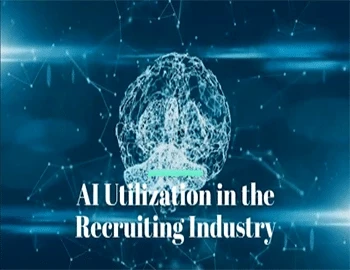
Artificial Intelligence Advancements In Professional Staffing
Artificial Intelligence (AI) has permeated everyday modern society. Professional recruiting and staffing firms are embracing the benefits that AI can lend to their organizations.
Advancements in Artificial Intelligence
Springer Publishing’s book Intelligent Techniques in Engineering Management cites AI strides of particular benefit to recruiting have been focused in the areas of:
- Candidate searches utilizing knowledge-based search engines.
- Resume Data Acquisition.
The Society for Human Resources Management article entitled, Recruiting Gets Smart Thanks to Artificial Intelligence recognizes the integration of artificial assistants and video interviewing. These AI Assistants communicate using natural language protocols. They not only ask questions but also provide answers to candidate inquiries. Less visible is the AI ability to locate and qualify passive candidates. Simply put, passive candidates are people being considered for a position but are not actively seeking a job. Artificial Intelligence can filter out the candidates who are most likely to engage in the recruitment process.
AI Utilization in the Recruiting Industry
Artificial Intelligence is most commonly associated with interactive avatars and virtual assistants, important tools to be sure. However, the strength of AI lies in its ability to gather and quickly analyze massive amounts of data. Imagine sifting through thousands of applications with precise scrutiny in a matter of minutes. AI has the capability to trend and perform pattern analysis. Recruiters use this data extrapolation power to the best advantage of job seekers and employers.
The top professionals in the construction, engineering and environmental industries are in high demand and short supply. Companies looking to hire them understand this all too well. Recruiters know that delivering the best candidates makes them highly sought after. That’s why they see the passive recruitment aspect of Artificial Intelligence as extremely useful.
AI Effects on Recruiting Construction, Engineering and Environmental Professionals
Artificial Intelligence is overwhelmingly beneficial to recruiters. Staffing agencies that incorporate AI technology are seeing immediate benefits. The number and types of software platforms are impressive and increasing rapidly. These are some of the most common types of software and their uses:
- Virtual Assistants – Talks to clients, answers questions and provides status updates. Some of these programs can autonomously schedule appointments and interviews.
- Video Interviewing – Aside from the obvious, this software often comes with voice analytics covering word choice, cadence and tone.
- Passive Candidate Identification – Identifies candidates who are not actively job hunting but have been selected as solid recruiting prospects. Opening a recruiter’s candidate selection pool immensely.
- Data Collection and Interpretation – Acquires and rapidly sifts, sorts, trends, selects and gives recommendations.
Staffing agencies that employ the use of AI software are equipped with several advantages:
- Increased candidate search capability.
- Increased access for clients and candidates, 24-hour access in some cases.
- Research, Acquisition, Interview and Hiring process streamlining.
- Cost and time saving.
- Enhanced data collection, assimilation and interpretation.
As artificial intelligence is increasingly woven into the fabric of modern staffing, the beneficial effects come to light immediately. Artificial Intelligence in recruiting engineering, environmental, and construction professionals is introducing new paradigms. Tasks that now consume a recruiter’s time will be eliminated or taken care of by AI. This will enable the staffing firm to prioritize its goals and sharpen its focus in ways that augment these new paradigms. Artificial Intelligence will make the process of recruiting construction, engineering and environmental professionals better, faster and smarter. For the candidate AI assists the staffing agency match them with opportunities that are closely aligned with their talents and goals. For employers AI helps the agency expeditiously find and deliver the best talent to match the needs of the employer.
Michael DeSafey is a leading executive recruiter for professionals in the construction, engineering and environmental industries. He is currently the President of Webuild Staffing www.webuildstaffing.com . To learn more about Michael or to follow his blog please visit www.michaeldesafey.com
Reaching Qualified Applicants in the Construction

Reaching Qualified Applicants in the Construction and Engineering Industry
Finding the right individual to fill a role in any industry can seem overwhelming, to say the least. It can take months of receiving and reviewing applications, interviewing potential employees, and posting advertisements online to find the candidates that best fit the role your company needs to be filled. When working in an industry such as construction or engineering, which require specific skill sets and methodologies, it can be more difficult. However, one of the most important aspects of attracting the most qualified applicants is in the way you create your job postings and advertisement
There are a variety of ways to approach advertising jobs within your company – and finding someone who will fit the expectations of your career path is one of the most important things you can to do ensure your company’s success. Below, we review a variety of important methods to successfully drawing in the most qualified applicants for all positions within your company.
Rethink Where You Post Job Opportunities
Culturally, we have moved to the age of the internet. In fact, there are entire websites dedicated to finding positions in specific industries, based on individual interest. Gone are the days in which individuals applied in person for positions. Instead, many individuals will look online for job postings. The medium through which an individual sees the job posting is going to be one of the most important factors, at the end of the day, to find your ideal applicants.
Furthermore, attending job fairs is another way to find applicants. Career-specific job fairs, like those that are often hosted at colleges, are a great way to find applicants who are new to the field and looking for opportunities. Additionally, job fairs provide both you, as the employer, with an idea of the employee pool, and provide applicants with the ability to develop an initial impression – and therefore, potential interest – of your company.
Do Away with Deal Breakers
Often, one of the things that will drive potential employees away from jobs are the deal breaker requirements. We all understand, there are certain positions that require certain skill sets. However, demanding that an employee have at least 5 years of experience as a high-level engineer with a masters degree in mechanical engineering may drive away potential employees who are highly skilled. Therefore, it is important to consider what your absolute necessities are – provide that in the description of your job posting.
Limiting your requirements will bring in more applicants who are genuinely skilled in the field. Often, individuals will not apply for a position whose job description makes them feel unqualified to do the work. Therefore, listing what is a requirement, and what may be “preferred” will encourage potentially excellent employees to apply for positions that they may not have otherwise applied for.
Think of the Posting from an Applicant’s Vantage Point
Putting yourself in some else’s shoes can be difficult, to say the least. However, it can be one of the most beneficial things you can do for your company to ensure qualified, skilled applicants are applying to your positions. When reading a job description, many individuals will look first at the requirements of the job, and then read the description. If they feel that they meet the requirements, they will review the expectations and duties of the role.
This is where you should consider the audience, you’re attempting to attract with your job postings. For instance, jobs whose description dictate that employees may receive little to no time off initially are less likely to attract potential employees, especially in the day and age in which individuals are looking for more personal freedom from work. Furthermore, having bleak job descriptions that make the work sound tedious will reduce the overall number of applicants you receive for the role.
Be Welcoming!
This is, in many cases, one of the most important aspects of creating successful job postings. With the new job force graduating college and developing career paths, in many cases, these new employees are looking for a job environment in which they feel appreciated. Presenting your company as one that wants to include and welcome employees will encourage individuals to apply, and often bring in talented employees.
Ultimately, the best way to find qualified individuals to fill roles in fields as demanding as engineer and construction career paths is to consider the expectations of the roles you are posting. Provide warm, welcoming introductions to these roles, and consider the development of the workforce presently. Combining these factors together, you will have far more success in recruiting individuals who are talented and prepared to take on the task at hand, ultimately improving your workplace.
Michael DeSafey is a leading executive recruiter for professionals in the construction, engineering and environmental industries. He is currently the President of Webuild Staffing www.webuildstaffing.com . To learn more about Michael or to follow his blog please visit www.michaeldesafey.com
2019 – 2020 Construction, Engineering and Environmental Salary Guide

2019 – 2020 Construction, Engineering and Environmental Salary Guide
Webuild Staffing’s 2019- 2020 Construction, Engineering and Environmental Jobs Salary Guide is now available.
Employee compensation is the one of the most critical issues facing employers in the Construction, Engineering and Environmental Marketplaces today. Demand is great to hire and retain professionals that will directly affect the projects organizations obtain and the overall financial success of construction, engineering and environmental firms worldwide.
The lack of highly, qualified professionals in the industry has add even a greater challenge to hiring and retaining those employees for long-term professional growth and organizational success.
The Webuild Staffing Salary Guides were created to give employers and individuals alike the resources necessary to effectively understand compensation levels. The guides are based on Webuild Staffing’s professional experiences recruiting exceptional construction, engineering and environmental professionals and working with employers to create realistic compensation programs to keep their organizations competitive in the upcoming years.
This most recent publication focuses specifically on the California and Nevada markets for the 2019 – 2020 time period. It will provide you a realistic expectation of compensation levels in 28 professional categories throughout the industry.
- 10 Construction Professional Classifications
- 10 Environmental Professional Classifications
- Classifications from Entry Level to Senior Executive
- 8 Engineering Professional Classifications
- Positions Classified by Expertise and Experience Level
- Focused Specifically on California and Nevada
Michael DeSafey is a leading executive recruiter for professionals in the construction, engineering and environmental industries. He is currently the President of Webuild Staffing www.webuildstaffing.com . To learn more about Michael or to follow his blog please visit www.michaeldesafey.com
How To Turn It Around When Candidates Turn Down Your Job Offer

How To Turn It Around When Candidates Turn Down Your Job Offer
You have identified the perfect candidate among a large pool of qualified (and not-so-qualified) candidates. You have examined his or her resume and been in contact with an impressive list of references. You have conducted multiple interviews with this person at various levels within your organization and embraced an amicable salary negotiation process. You are ready to cross the finish line on the hiring process and extend a generous offer to the ideal candidate, but then the unthinkable happens – your dream candidate creates a nightmare scenario when he or she turns down your offer of employment.
Believe it or not, these days it is not uncommon for many organizations – particularly small businesses – to feel the strain of stiff competition for qualified workers. In a strong economy with low unemployment, the pool of job seekers constricts significantly. The engineering industry, in particular feels this pain acutely.
If your organization is struggling to turn job offers into job acceptances, there are a number of proactive steps that you can take to increase the odds of your ideal candidate becoming an ideal employee.
Find Out The Buzz on Your Business Online
Now more than ever, job seekers are empowered with inside knowledge about your organization. A wealth of information about your company’s inner workings and leadership, processes and policies, strengths and weaknesses are merely a simple Internet search away.
It is imperative that you plug into online databases and review websites to get a clear picture of what prospective employees are reading about your company. Follow-up with an internal review to determine which claims are legitimate and which claims are the ramblings of disgruntled former employees. You can’t change every negative review, but you can course correct on the things that matter and address these changes with prospective candidates during those crucial discussions on your company’s culture.
Reexamine Your Hiring Process
Of course, it is in your organization’s best interest to be thorough with its hiring process – you want the best candidates possible to win out. Take some time to think about your hiring process from the candidate’s perspective. Lengthy processes can be off-putting to job seekers, particularly when they unfold with little or no communication from the main organization.
If your company follows an extensive hiring procedure that includes a detailed application, multiple rounds of interviews, background checks and even more interviews before candidates even reach the salary negotiation stage, try to find areas in the process where you can streamline the process. Consider combining interviews with key company personnel to cut down on the number of individual interviews. Try conducting background checks upon completion of the application to speed up the process.
Maintain Lines of Communication
Sometimes a lengthy hiring process is an absolute requirement – this is particularly true for engineering, construction and environmental industries. In these cases, it is vital that your organization maintain open lines of communication with prospective candidates. Let them know where you are in the hiring process. Provide them with anticipated completion dates and deadlines.
This may represent a small shift in your hiring process, but it can have an enormous impact on prospective candidates’ positive perception of your organization and reflects well on your company’s overall culture. It could make the difference between getting a yes to your job offer or getting turned down.
Ask Why Not
When you get turned down by your dream candidate, don’t hesitate to politely and professionally ask why he or she rejected your offer of employment. The answers you receive will likely be varied and range from compensation and company culture or just getting a better offer elsewhere, but the information you discover can pay dividends in terms of how you conduct the hiring process with future prospects.
Finding the ideal candidate for your organization can be difficult, particularly in the highly-specialized construction, engineering and environmental industries. Using a firm like Webuild Staffing to partner with in finding top-tier talent may help.
Michael DeSafey is a leading executive recruiter for professionals in the construction, engineering and environmental industries. He is currently the President of Webuild Staffing www.webuildstaffing.com . To learn more about Michael or to follow his blog please visit www.michaeldesafey.com
An Overview of the Water Resources Industry – Professionals are in Demand

An Overview of the Water Resources Industry – Professionals are in Demand
Manpower shortages have been forecast for the water resources industry conservatively since 2005. The American Water Works Association 2018 Status of the Water Industry report gives a grade of 4.7 out of 7 to the industry overall. The workforce was assigned a 4.1 rating. As these forecast are being realized, the workforce picture continues its downward spiral. The Florida Rural Water Association Workforce Needs Assessment cites a declining number of science and technical degrees and retirement as some of the reasons for the shortfall of engineering professionals. That assessment also references a growing trend for college students to choose non-technical degree fields.
Other reasons for low staffing levels are due to a lack of awareness. Many people in the water resource industry did not enter it purposefully. Often they become aware through friends or experts in career guidance. The industry however, has a large number of entry paths and is ripe with advancement opportunities.
The Employers
The Water Resource Industry is widespread and covers a broad swath of engineering disciplines; Civil, Construction, Environmental, Electrical, Mechanical, and Design Engineers to name a few. This diversity results in the industry being made up of many different types of companies:
- Engineering firms, especially those specializing in design, construction, hydraulic modeling, environmental consulting, chemical and process engineering.
- Public Utilities and Public Works departments employ numerous engineers who have specialties in water production, wastewater treatment, construction or maintenance. Project management experience is a plus. Many municipalities have paid internships. These internships are usually not well publicized.
- Large Water Treatment Facilities (both private and municipal) employ civil engineers, treatment plant managers, water quality managers, as well as a multitude of consultants and contractors.
- Membrane Filtration companies, electric cooperatives, and chemical plants are also seeking professionals to fill vacancies.
The concern for sustainability initiatives and the implementation of green processes continues to grow. In response, many municipalities and private sector entities are creating entire departments to help address these environmental issues.
Career Opportunities
The industry offers many opportunities for engineers and other technical professionals. Hydraulic modelers, Design, Civil, Chemical, Environmental and Project Engineers are in demand. Utility Directors, Assistant Directors, Junior Engineers, Chemists and Plant Managers are being sought nationwide. Companies need Water Resource Engineers, Water Resources Technical Managers and Engineers skilled in biological processes.
Industry Trends
Forecast trends do not show the gap decreasing. In fact the opposite is true. Trending points to an increase in manpower shortfalls.
Staffing Firm Advantages
The Water Resources community strives to strengthen its recruiting efforts through various committees, outreach programs and staffing agencies. Using the services of a top notch staffing firm will afford you many advantages. These firms have the resources and professional network connections that open doors to opportunities you can’t find through a Web search.
The best firms are intimately aware of the career progressions and paths that lead to hiring. They know the qualifications employers are seeking. Often an employer will bring a candidate on board knowing they will be able to achieve a particular qualification. A tier one firm will be able to accurately represent your accomplishments, goals and worth to prospective employers.
A few of the most valuable advantages that a premier Staffing Firm offers is that they are invested in you and view your career as unique. They also recognize that a best fit scenario is a win for both you and the employer.
Michael DeSafey is a leading executive recruiter for professionals in the construction, engineering and environmental industries. He is currently the President of Webuild Staffing www.webuildstaffing.com . To learn more about Michael or to follow his blog please visit www.michaeldesafey.com
What Can a Strategic Thinker Bring to a Construction, Engineering or Environmental Firm.

What Can a Strategic Thinker Bring to a Construction, Engineering or Environmental Firm.
What is a Strategic Thinker?
A strategic thinker is someone who possess a distinct set of skills that can keep a company moving forward in growth. They can anticipate, think critically, interpret, decide, align, and learn. But what does this mean? Strategic thinkers can anticipate the needs of the company and problem solve and getting to the bottom of a situation by analyzing every aspect of it. They can interpret the meaning behind data pertaining to their success as well as make executive decisions that will steer them even closer to success. Furthermore, they can get everyone on the same page by presenting the facts and keeping those around them informed and at ease.
The Importance of a Strategic Thinker
Having at least one strategic thinker on every work team is essential for the smoothest running job sites. As the name implies, strategic thinkers can take in the information around them and turn it into a detailed plan, addressing the needs of the company in every way possible. Engineers and construction workers who have the ability to think critically possess one of the most valuable traits of a strategic thinker.
In fact, it is difficult to even become an engineer without being a strategic thinker. Most people are only able to assess a situation at face-value while someone who can think critically is able to run through the what-if scenarios, thus addressing problems with the best fitting solution. Strategic thinking engineers are able to more effectively troubleshoot their equipment and come up with new, more efficient ways for their company to run. They do this by being able to interpret data from past experiences and scenarios and learning from past resolutions, combined with anticipating the current and future needs of the company.
Strategic thinkers do very well in management positions. With their critical thinking and anticipation qualities, they can discern with stunning accuracy how well an interview candidate will perform for the company. Their ability to make decisions is unparalleled. A project manager at a construction site who possesses the ability to mentally weigh the pros and cons of every potential outcome, is an asset any construction company would love to have. They can make educated, informed decisions about potential employees or project proposals. A construction site manager who is a strategic thinker will be able to deduce any potential problems with a blueprint or budget spreadsheet and deduce the best way to solve those specific problems. The construction site manager will then be able to address his concerns and solutions with the company, customers, and his own coworkers and employees to ensure everything runs smoothly with everyone on the same page.
Identifying a Strategic Thinker in a Job Interview
I am sure by now you are thinking, “Where can I find one of these people?” Using a few specific tools in your interviewing process can be crucial in identifying the strategic thinkers from the “looks good on paper” employees.
First, you can give each candidate a problem to solve. Describe the problem to the potential employee and give them a few minutes to think about it. For example, you ask an environmental engineer how they would correct an excessive amount of waste at the local landfill. Ask them to describe the steps they would take to solve the problem. If they are a strategic thinker they should have compiled a list of potential problems and a strategic plan, are looking forward to future company forecasts and identifying outside economic or environmental factors, and are figuring out how to consult with company stakeholders or customers. You are looking for an omission of any of these steps such as not addressing how customers may perceive this solution. For example, if their solution is greatly increasing the cost of garbage services, they may not be thinking of the customer. Also, be on the lookout for a solution that does not have enough strategic focus. They may state that merely hiring more landfill employees to attempt to get the situation under control is all it would take, neglecting the fact that it will then cost more money to pay new workers which could increase the cost to the customer and reduce profit for the stakeholders.
Ask them questions and pay attention to the questions they ask you. A true strategic thinker will be excited about the potential of a strategic challenge and will ask many questions regarding it. The environmental engineer will want to know how long the landfill problem has been prevailing, if it has ever happened in the past, and if it is projected to continue to worsen. Finally, if you are still not sure, consider presenting them a flawed solution to a company problem and see how they strategically alter it to be more profitable. Present to your potential construction site managers a project site that has been rezoned and no longer matches the initial building plan. They will weigh the changes needed to be made by thinking about costs to customers and company, as well as any environmental impacts. With enough questioning, a strategic thinker will all but identify themselves. Remember, how they respond to your specific questions is how they will respond to situations in the work environment.
Michael DeSafey is a leading executive recruiter for professionals in the construction, engineering and environmental industries. He is currently the President of Webuild Staffing www.webuildstaffing.com . To learn more about Michael or to follow his blog please visit www.michaeldesafey.com
How Great Leaders Mentor and Motivate Their Staff in the Construction, Engineering Industries

How Great Leaders Mentor and Motivate Their Staff in the Construction, Engineering Industries
It’s not enoLeadershipugh to have a vision for your company. You, as a leader, must mentor and motivate your employees to see that vision. They have to believe in you and your mission if you want to rise to the top of the industry.
How do you do it? It’s no accident. There are a few things all great leaders do, some of which are especially important to the construction, engineering, and environmental industries.
They Act the Way They Want Their Employees to Act
Forbes refers to it as demonstrating integrity, not just preaching about it. At Arkansas State University, “taking initiative” is one of the focal points of the Engineering Management program. If you want your employees to be kind, respect each other, make decisions, and follow through, you need to demonstrate that in your role as manager.
They Communicate
Research by the Chartered Institute of Building found that construction professionals consider communication to be the most important skill for a leader in the industry. First, it’s important to be able to clearly communicate what needs to be done. Then, you want to make sure you’re maintaining an open, friendly line of communication, so your employees always feel they can speak with you about issues or concerns. They need to find you available and willing to listen with no fear of judgment or ridicule.
They Encourage Growth and Development Among Employees
In a lecture at Monash University entitled The Role of Leadership for Environment and Sustainability, both formal and emergent leaders are mentioned. Formal leaders are those assigned to roles, like project managers; emergent leaders are people who take on extra responsibility and demonstrate leadership qualities. Both are essential to sustainability.
Therefore, as a formal leader, you have a responsibility and an opportunity to nurture leadership in your employees. They will be the ones to help you take the company to the next level. By taking an interest in your employees’ personal and professional growth and development, you show you care about them as individuals, not just as employees.
Forty-three percent of construction industry professionals indicated they were significantly influenced in their careers by a superior manager. What kind of influence do you intend to have?
They Take Responsibility and Give Credit Where It’s Due
Despite your best efforts, sometimes things go wrong. When you stand up and take responsibility for your role in a mistake, it builds trust among your employees. They know you won’t unfairly blame them to save your own reputation.
At the same time, a good leader doesn’t take credit for something his or her employees accomplished. Honoring the work they’ve done inspires them to continue.
They’re Flexible
No matter what industry you’re in, throughout your career you’ll be working on a variety of projects with a variety of personalities. For example:
Furthermore, that flexibility will allow you to change direction in a given project to achieve the best results, perhaps based on ideas or feedback from one of your employees.
They Show Their Appreciation
A little gratitude goes a long way. Making your employees feel valued is an essential leadership quality. This post talks suggests getting to know your employees and giving rewards for stellar safety records and other achievements, noting that “…showing gratitude for your workers can help your construction company’s bottom line” because, quite simply, happy employees do a better job.
This all comes down to one overarching quality: honesty. When you act with integrity, communicate openly, show your gratitude, and listen to your employees, they learn to trust you. When they trust you, they can follow you, and then you can lead the company where it needs to go.
Michael DeSafey is a leading executive recruiter for professionals in the construction, engineering and environmental industries. He is currently the President of Webuild Staffing www.webuildstaffing.com . To learn more about Michael or to follow his blog please visit www.michaeldesafey.com
Tough Job Interview Questions You Should Be Asking

Tough Job Interview Questions You Should Be Asking
As a hiring manager, there several things you want to know about potential candidates. You want to know that they’ll be hard workers, that they have the skills required for the position, and that they’re bringing a great attitude to your workplace. There are some questions that are hard to ask when you’re sitting in an interview–and hard to answer when you’re sitting on the other side of the table–but these tough questions are critical to getting to know your candidates.
1. What salary range do you expect from this position? Whether you’re working for an environmental firm or a construction company, you want to set this question on the table early. Your goal is to get the candidate to name a number–hopefully a lower number than the amount you’ve got budgeted.
2. Why are you leaving your current position?
This question puts the candidate on the spot, but it will also tell you a lot about their personality. There are several key things to look for in the answer:
• Does the candidate list things that are equally common in the position they’re applying?
• How does the candidate talk about their former employer?
• Does the candidate have a laundry list of complaints from their previous jobs?
• Is the candidate positive about new career opportunities with your company?
3. Have you ever been fired or laid off from a previous position? Why? Ouch! The best candidates may have stories about past failures that led to them being laid off–and those stories are things you need to know about them before you hire them. If you’re going to ask this question, however, be sure you give the candidate an opportunity to prove the changes they’ve made as a result of being fired in the past. For example, a construction worker who was guilty of slacking off on job sites in the past might have become an exemplary worker since then. An engineer who was always late might have developed new habits so that they’re always the first one at a meeting. Give candidates room to grow, but understand their past failures, too.
4. Why should I hire you? Some candidates will go blank when they hear this question. Asking it, however, will give you a look at how the candidate views themselves and how they’ll perform in the position. How you ask this question, from your tone of voice to your body language, will help set the stage for the candidate’s answer.
5. What do you need, other than money, in order to ensure your job satisfaction? This is the candidate’s opportunity to tell you what they’re really looking for in their dream job–and your chance to learn whether or not your company can provide it. If the candidate’s expectations are far too high for your firm to reach, they might not be the right one for your open position.
6. Imagine giving your last boss a performance review. What do they need to improve? The candidate’s answer will give you a good look at their personality. It’s not information about the boss you’re looking for; instead, you’re looking to see what the candidate expects in a boss and how they handle things that they don’t like in a person.
7. What is your greatest weakness? Every candidate has a weakness. Most of them will try to give you an answer that they don’t see as being a true weakness. The best candidates, however, will give you a look at how they’re learning to overcome those weaknesses or how they have turned them into strengths.
Asking the right questions in a job interview is just as important as knowing what answers you’re looking for. Ideally, you want to ask questions that will help you learn more about the candidate’s deeper personally. The best questions will catch them slightly off-guard, without a prepared answer at hand. As you delve into those questions, you’ll get a solid look at what’s really behind a candidate’s interview persona–and that will go a long way toward helping you make hiring decisions.
Michael DeSafey is a leading executive recruiter for professionals in the construction, engineering and environmental industries. He is currently the President of Webuild Staffing www.webuildstaffing.com. To learn more about Michael or to follow his blog please visit www.michaeldesafey.com
7 Ways to Be a Great Construction, Engineering, or Environmental Industry Mentor

7 Ways to Be a Great Construction, Engineering, or Environmental Industry Mentor
Young professionals in the construction, engineering, and environmental industries who are serious about rising to the top of the profession will seek a mentor to guide them through their education and early career. A good mentor can provide insight into the industry and help these young professionals find the opportunities that will develop their skills and expertise.
This article speaks specifically about the importance of mentoring in the construction industry, and why it’s critical “…to invest more heavily in the success of the youngest ones among us—personal, one-on-one mentoring…to identify potential and encourage professional development.”
The author shares how the one-on-one attention he received throughout his career brought him to where he is today. In this interview, a construction project manager says that mentoring was key to keeping her in the industry, and she suggests it as a method of retaining top talent.
Becoming a mentor is a privilege, but it’s also an opportunity. You might find yourself connecting with some promising talent that you can bring to your firm, or if your mentee is already at your firm, you have the opportunity to guide him to a position that will benefit the entire company. It’s a job that should be taken seriously. Here are seven tips to help you be a great mentor.
Be Honest
Do you really want to be a mentor? Is it inspiring, or do you feel like it’s a hassle? To be a great mentor, you have to want to be a mentor. If you don’t feel you can offer your mentee what she is looking for, don’t agree to the position.
Be Clear About Expectations
Each mentor-mentee relationship is unique. Some mentees might want to pick your brain once over dinner. Others will meet with you regularly for years. The Environmental Leadership Mentoring program at Yale University requires that you “…outline the structure and expectations of the relationship” and “work with your mentee to set professional goals for the year.”
This Journal of Extension article confirms that having clear roles and responsibilities and clear long- and short-term goals are important to a healthy mentoring relationship. If you’re not both happy with the arrangement, you’re both better off finding a new partner.
Know Your Focus
A young anthropologist is best matched with an experienced anthropologist, not an oceanographer. Make sure your mentee has goals that line up with the career path you’ve taken so you can best mentor him along that path.
Ask and Listen
Even if you’re in the same field, your mentee might not have the vision of his or her role in the industry that you do. Listen to what your mentee has to say not only about her career, but about her family, hobbies, and other priorities. Getting to know your mentee as a person and as a professional will help you guide him toward the education and opportunities that best suit him.
The Center for Construction Research and Training shared the results of this study, which listed “Is a good listener” as the most important quality in a mentor in the construction trades.
Find Unique Opportunities for Your Mentee
Use your knowledge and connections to help your mentee find classes, seminars, and other opportunities she might not be able to find on her own. You don’t need to call in any favors; simply keep an eye out for ways to help your mentee advance her career. EPICS in IEEE mentions how mentoring can help young engineers expand their networks.
Share the Ups and Downs
This goes for your own career as well as his. Don’t hide your mistakes or regrets, past or present. Tell your mentee about the times in your career when you wish you had done something differently. “Willing to share negative information” was the second most important quality in a construction mentor as shared by CPWR.
Take a look at the major issues in your industry. In construction, help your mentee consider what can be done about the lack of qualified workers. In the environmental industry, examine the challenges of building a successful business while protecting the environment. All three industries need professionals who are ready to tackle the added complexities of new technology and environmental sustainability.
At the same time, remember to share your own career highlights, and celebrate with your mentee when he passes a class, gets a promotion, or lands his first major client.
Set the Bar High
Conduct yourself, personally and professionally, in the way you’d hope to see your mentee emulate. This goes for your own projects and continuing education as well as how you run a meeting, talk about clients when they’re not there, and relate to your co-workers. Your mentee is definitely watching.
Being a great mentor can be as rewarding for you as it is for your mentee. Seek opportunities to serve as a mentor within your own firm or through a local university. For example, many universities, including the University of Arkansas, Iowa State, and Penn State, have specific mentoring programs for their engineering students. Be open to those who approach you for mentoring. You might even consider starting a mentoring program within your organization to build a strong team of motivated professionals for your company.
Michael DeSafey is a leading executive recruiter for professionals in the construction, engineering and environmental industries. He is currently the President of Webuild Staffing www.webuildstaffing.com . To learn more about Michael or to follow his blog please visit www.michaeldesafey.com
Using Body Language as a Business Leader

Using Body Language as a Business Leader
As a business leader, you have to develop plenty of skills. Leadership means wearing many different hats and accomplishing many different tasks over the course of the day. One of the most important skills you’ll learn, however, is how to use your body language in order to impact the attitude and motivation of your employees.
Contagious Attitude: The Power of a Smile
When you’re stuck in the middle of a stressful day, the last thing you want to do is paste a smile on your face and pretend that everything is going well. This simple action, however, can make a big difference, not just for you, but for your employees, as well. When you smile, your employees will be more likely to smile back at you.
The simple action lowers stress hormones and releases hormones into the reward centers of the brain, thereby making your entire team feel better about the stressful day you’re having. Not only that, when you smile, you’ll increase your own satisfaction, which makes it more likely that you’ll remember to do things like complementing the employees who have gone above and beyond for you during this difficult time.
Keep Your Head Straight
Confidence is one thing; being cocky is something else entirely. When you’re in a meeting or listening to someone else speak, make an effort to keep your head straight. Tilting it to the side gives an impression of cockiness, which is not the impression you want to convey.
Use the Right Tone
Your tone of voice has a huge impact on how people perceive you. You can say all the right words, but if your voice doesn’t hit the right level, your employees aren’t going to respond to it the way you want. A confident leader typically displays several key characteristics in their speech:
- A lower pitched voice
- Sentences that are carried confidently through to completion rather than dropping off at the end
- Dynamic inflection
- Clear articulation
Control Movement to Attract Attention
When you want the eyes of the employees you’re managing to be on you, move to attract their attention before you speak. You’ll find that people are naturally drawn to movement, which means that shifting your position by just a step or two is enough to make sure that there are more eyes on you. Ceasing movement helps to underscore the point that you’re making once they’re looking at you–not to mention making you appear more decisive.
Reduce the Appearance of Tension
When you are calm, relaxed, and confident, you’re more likely to inspire the same emotions in everyone around you. By reducing the appearance of tension, you can substantially change the attitude of the room. After all, you believe in your employees and their ability to accomplish the goal in front of them–that means they can believe in themselves, too. A few simple exercises can help you learn to relax the natural tension in your face, neck, and shoulders, changing the image you present to everyone around you.
Pay Attention to Employees
If you want to increase the odds that people will participate in a discussion, share their problems with you, or give their best to projects that you’ve assigned, the best tactic is to ensure that they know you care about their participation–that is, to look like you’re listening. Don’t multitask during meetings or when an employee is talking to you. Instead of talking over them, take the time to listen to everything they have to say before formulating your response. These simple steps can make a big difference in how you are perceived by your employees.
Learning to use body language to your advantage is a great way to make more out of every interaction you have with the employees who work with you. By practicing a few simple controls, you can change the way they perceive you, shape your workplace culture, and better motivate every employee throughout the business.
Michael DeSafey is a leading executive recruiter for professionals in the construction, engineering and environmental industries. He is currently the President of Webuild Staffing www.webuildstaffing.com . To learn more about Michael or to follow his blog please visit www.michaeldesafey.com
Steps To Consider When You Decide To Start Your Own Construction Company

Steps To Consider When You Decide To Start Your Own Construction Company
The construction industry is very competitive. More and more professionals in the construction industry are moving up the corporate ladder. They are doing the time and building up the skills and construction management know-how. They have every bit of expertise as their bosses and many are contemplating starting their own firms.
With the market now growing at a normalized rate, now is the time to take the leap at start a new business. If organized right, your construction company can get to the next level, employ many people, add to the economy and bring home a very nice profit. So there are a few important things to consider when starting your own construction firm.
First, make sure you have the client base in place. That means networking with investors, lawyers, bankers and accountants that can point you in the right direction. Most of all, you need to have number of existing relationships with large and medium sized developers and governmental agencies that can hire you and your team.
Secondly, make sure that you have the capital in place to finance your team, tools and equipment. You will also have administrative costs to run an office including rent, staff and the day to day issues. The funds can come from a loan, an investment or your personal funds. The SBA may even provide a loan.
Third, make sure to get all of your licenses and bonds so that clients will take you seriously. You also need to pay for insurance which will come when you have enough financing. Working on risky projects requires a big expense for insurance costs.
Lastly, you will need a way to staff up your firm. You need to work with third party organizations that have the resources and network to quickly grow your team with high quality individuals.
WeBuild Staffing is the leader in helping construction and engineering firms to build up their teams quickly. In a pinch, the company can produce many high quality workers and team members to help establish your growing business.
Michael DeSafey is a leading executive recruiter for professionals in the construction, engineering and environmental industries. He is currently the President of Webuild Staffing www.webuildstaffing.com . To learn more about Michael or to follow his blog please visit www.michaeldesafey.com
What You Should Know About Hiring Millennials

What You Should Know About Hiring Millennials
In the construction industry, it will very often be necessary to hire within the generation known as millennials: the ones who grew up being told they could do anything, with social media always by their sides–they’re from a different world than other generations, and they bring an entirely new perspective and attitude to the workplace. To properly choose the employees that you know will succeed, and to further motivate them, here’s what you should know about hiring millennials:
They’re intrinsically motivated. This means that millennials care less about rewards than you may think: they want purpose, they want positive feedback, and they want to grow in their careers. This means you’ll need to be aware of your management; criticism should be constructive, and praise should be offered any time you see great work. For hiring, this means you should stress the opportunities for growth that are available, and if possible, offer a mentorship program. Flexibility in hours is difficult in construction, but if you can offer any, make sure it’s known in the hiring process, as millennials place importance on this, too.
They’re idealistic. This means they may job hop until they find a situation that benefits them best for their goals. But it also means (and this is important) if they care about the job they have with you, they’ll want to make a difference in the workforce. You’ll want to show them how you’re contributing to the local area’s entire lifestyle–and as millennials can tend to be more in tune with technology, and less with labor, be sure to give them the time and flexibility to discover which role within your construction company may provide the best fit. You may even find that if you hire the right fit for your company, a truly motivated person, they’ll start finding ways to improve business you never thought of.
They can tend to be individualistic. (Meaning, not team players–which is not always great news for the construction industry.) How do you find the millennial you can mold and fit to the team? For one, hire for skills rather than personality. If the millennial you hire is suited more to your construction opening, then they’ll be more likely to want to stick around and to fit with the team. That being said, millennials are motivated by great work and great people. Surround them by an appropriate team and with good mentorship, and you’ll find a vast difference in their growth with you.
Hiring millennials will become increasingly important for you in the construction industry, so it’s very valuable to understand this generation’s needs and motivations. With the right approach, millennials with your construction company could make a wonderful difference and help your organization succeed.
Michael DeSafey is a leading executive recruiter for professionals in the construction, engineering and environmental industries. He is currently the President of Webuild Staffing www.webuildstaffing.com . To learn more about Michael or to follow his blog please visit www.michaeldesafey.com
Skills You Weren’t Taught in School – Networking For Career Success

Skills You Weren’t Taught in School – Networking For Career Success
At first you will find it tough going, but with time and experience, it becomes like second nature. Because you know the why, and have learned the how.
One of the most difficult activities engineering and environmental professionals are tasked with is Business development; networking. You understand the technical aspects to your job; the science and engineering (the why), but the how (how to build relationships, how to establish clients, and how network with associates) is beyond your education. This is a skill you most definitely were not taught in school and need to develop as a professional to advance your career. But where do you start?
Here are some tips on how to network:
- It’s important to remember that no one ever died from networking (we checked).
- Start out by attending an association luncheon. If you choose an event with a speaker or topic that you’re interested in you’ll have something to talk about during the networking session.
- Bring cards and be prepared with your elevator speech. This is who you are, who you work for, and how your firm relates to the days topic, in 30 seconds. If your marketing department doesn’t have that message crafted, try Google.
- Have a plan. If the event attendees aren’t listed online, show up to the event early and scan the name tags. Make a mental note of who you’d like to talk to.
- If you recognize a name of someone you don’t know but would like to meet (a decision maker at a potential client firm, perhaps), hang out at the registration table and see who picks up that name tag.
- As other attendees show up, it’s ok to make a beeline for a friendly face. Ask your friend to introduce you around. Caveat: don’t hang out with your friend for the entire networking session. Give her time to mingle on her own; make sure you mingle on your own as well.
- The easiest way to find someone to talk to is locate a person standing by himself, wishing he were anywhere but there. Put your nerves aside, walk up, and say hi.
- (Speaking of nerves, it’s perfectly normal to be nervous. Many seasoned business development professionals get butterflies before every networking event).
- The best ice-breaker is to ask your new acquaintance about himself. People loveto talk about themselves.
- Ask open-ended questions. A yes-or-no question is a conversation killer. Lead him with questions that lead to more questions, but don’t interrogate him!
- It’s ok, even preferable, to talk about topic other than business. Relationships are developed over time by getting to know someone as a person, instead of potential work.
- Know when to move on. Don’t monopolize one person’s time, or let one person monopolize yours. Once you make an acquaintance, learn about him and exchange information, move on.
- Make it your goal to meet at least three new people during the networking time. This will keep you moving around and maximize the use of your time.
- When it’s time to be seated for lunch DO NOT sit with someone you’ve already talked to. This is the time to find one of the people you want to meet and find a seat at, or near, her table. Introduce yourself and chat for just a moment, with a promise to follow-up at a later time.
- Once everyone is seated, pass a stack of your cards around the table. Everyone else should do the same. Then introduce yourself to the people on either side of you. Keep the conversation light. Now is not the time to set meetings or discuss projects.
- Please, please, use common sense when making conversation! Politics, religion, sex, or anything controversial is off-limits.
- Industry gossip, no matter how juicy, is also off-limits. You don’t know who knows who, and the very nature of gossip is negative. Don’t get drawn into it.
- After the presentation is over, close the loop with your table mates and the other people you talked to. Everyone has to get back to work, so now is not the time to strike up an in-depth conversation.
- The most important part of any networking event is the follow-up. Send an email to every person you met. Remind them of your conversation, provide any information you promised to share, and ask for a follow-up meeting.
The more often you attend events, the wider your circle of contacts becomes. Keep in touch with your network. Develop relationships, share information, and move forward in your career.
When you’ve built your network and are ready for new opportunities, contact us. We work with a large group of industry leaders who are interested in hiring quality engineers.
Michael DeSafey is a leading executive recruiter for professionals in the construction, engineering and environmental industries. He is currently the President of Webuild Staffing www.webuildstaffing.com . To learn more about Michael or to follow his blog please visit www.michaeldesafey.com
7 Steps To Create A Marketing Plan For Your Career In the Construction Industry

7 Steps To Create A Marketing Plan For Your Career In the Construction Industry
7 Steps To Create A Marketing Plan For Your Contracting Business the construction industry is vital to surviving in this competitive marketplace. A marketing plan is your own customized “roadmap” to advance your career and/or business throughout the year. It is an internal planning mechanism to keep you focused and to help you reach your goals as a contractor / business owner. There are seven important steps to devise a well-developed marketing plan.
Step 1: Develop an overview. You need to answer questions such as why you are in the construction business, and your marketing goals and priorities either to find a job and/or to gain new clientele. What kind of services do you provide such as commercial, residential, new construction only, or do you accept tenant improvement jobs on existing buildings?
Step 2: Create your brand. What type of image do you want to create for your customers? How do you convey this image to the public? Think about how your past employers and/or customers would describe your abilities. Do you provide a specialty service, or are you known for intangibles such as having integrity and transparency?
Step 3: Define your differential advantage. What sets you apart from your others? Why do your customers come to you over other companies? Do you go that extra mile and do things above and beyond what is expected? Maybe you only use the highest grade of materials. For example, why would a person building their own home choose you to build it over another company? This is your differential advantage.
Step 4: Determine your target markets. Who are your clients? Write in detail a profile of who does business with you. Their ages, location, position, and so forth, and of who you want to do business with, and whether you do residential or commercial work.
Step 5: Determine your online presence. Do you have a website? Should you? Think about the potential benefits from online marketing and the amount of potential clients you could reach.
Step 6: Decide your strategic action plans. Design a marketing campaign and specific techniques to put your plan in motion. Is it realistic and does it fit into your budget? Do you stand to profit from your ideas? Do your ideas represent your company well?
Step 7: Put your plan in motion. Implement your marketing plan and campaigns. Remember, your plans are not written in stone. You can throw out ideas that aren’t working and implement new strategies where necessary. Don’t be afraid to try new ideas and keep tabs on your competition and learn what works for them.
Developing a successful marketing plan is overwhelming to some business owners, and understandably. It is an involved process, but absolutely vital to your company’s success. You will need to take advantage of everything your company can benefit from in today’s competitive market. It will be your key to achieving your goals and becoming successful contractor in the construction industry.
Michael DeSafey is a leading executive recruiter for professionals in the construction, engineering and environmental industries. He is currently the President of Webuild Staffing www.webuildstaffing.com . To learn more about Michael or to follow his Blog please visit www.michaeldesafey.com
Hiring The Best For The Job: The Top 5 Character Traits To Look For In A Job Candidate

Hiring The Best For The Job: The Top 5 Character Traits To Look For In A Job Candidate
Trying to hire the best person for a job in the construction, engineering, or environmental industry can be a difficult maze to navigate. Many applicants may look good on paper, but how do you know which one to choose? Here are five characteristics to look for in a candidate during your hiring process:
Communication – The applicant has to be able to properly and clearly communicate with co-workers, site managers, and customers, among others. Having instructions get misstated, or be unclear, can negatively impact your business. A candidate must be able to concisely communicate instructions, safety information, deadlines, and budget restrictions when necessary. Confusion on the job site, or in the office, can lead to possible added expenses and/or injuries.
Time Management – Sometimes at a construction site, or on a line in a factory, an employee may be left unsupervised for extended periods of time. When this happens, you have to know that they are making the most of their time on the clock. If they are not very good at prioritizing their tasks and managing their time, they could end up wasting most of their time rather than utilizing it. This can run into budget issues, deadline problems, and production issues. It can throw your schedule off for completing a job on the building site.
Problem Solving – Problems will always pop up when you least expect them. From running out of nails, to a machine breaking down, to another employee not showing up for work — there will be days where if something can go wrong, it will. Knowing that you have an individual in place who can take care of those problems can give you peace of mind and open you up to applying your time and attention to other important issues. Hiring someone who can cover another employee’s shift, who can find additional nails to finish up a particular project, or who can get your project fixed in an expedited manner will be someone you will be glad to have working for your company.
Passion for the Job – If you have an employee on a construction site, or in the design office, who is not passionate about their line of work, you could be missing out on a valuable input source. Someone who knows the details of their career can offer opinions on helpful updates, innovative ways to do things, and safety suggestions. They can also help train other employees as needed, and they can turn out to be a valuable part of your team. Passion for the job can lead to a happy employer, and an even happier employee.
Business Aware – Not only does the ideal candidate have passion for their field of expertise, they are also aware of the business aspects of the field. Understanding that there is more to the job than just getting it done — it has to be done right, on time, and on budget is an important quality to look for in a candidate. They understand that there may be a schedule to watch out for, quality control to contend with, and materials that will have ordered — and they are aware that there are other businesses out there that their company is competing with.
Michael DeSafey is a leading executive recruiter for professionals in the construction, engineering and environmental industries. He is currently the President of Webuild Staffing www.webuildstaffing.com . To learn more about Michael or to follow his Blog please visit www.michaeldesafey.com
How To Be An Authentic And Effective Leader In The Construction, Engineering And Environmental Industries.

How To Be An Authentic And Effective Leader In The Construction, Engineering And Environmental Industries.
Business leadership is a complex subject, even though most of those who offer advice about it try to simplify things. It is one of those subjects that can be described with straightforward universal truth, but also relies on a myriad of details, many of which drive people who prefer the concrete and the predictable.
The construction and engineering industries are professions that are full of exactness. Materials do this, wires do that, this many bolts of such and such a size will hold up this much weight, and so forth. While that kind of data isn’t quite as plentiful in leadership, there are principles there to guide construction managers, engineers, environmental specialists and other professionals working within the construction, engineering and environmental industries.
Honesty
More than anything else, people who follow a leader want honesty. The reasons are fairly clear, given the relative absence of this virtue in modern business. A straight answer goes a long way towards building confidence. One thing you will always hear from people who admire a certain leader is that “you always know where you stand with him/her.”
Be that leader and you will inspire the kind of confidence that will make your job a lot easier. This is especially true in a role where many of the people you lead are experts in their fields. It is far easier to engineer a building than it is to engineer a consensus. However, if your leadership is built on honesty, that difficulty doesn’t have to be insurmountable.
Action
General Patton was famous for his quote (paraphrasing) “an imperfect plan executed today is better than a perfect plan executed tomorrow.” Action in the face of indecision is the mark of all great leaders, whatever the consequences of their decisions. Making mistakes is something common to all people. Presuming you are immune to error just because you’re in charge now is not realistic and will lead to one of two undesirable outcomes.
First, you’ll be more likely to make a wrong decision because you think you can do no wrong. Two, you’ll be less likely to make a decision at all, which leads to a bottleneck problem. Taking action while accepting the possibility of failure is absolutely crucial. Without this, nothing gets accomplished.
Construction and engineering are two disciplines that professionals can find themselves stuck between planning and building. Making sure the organization has forward momentum is just as important as the plans and the work.
Delegate
By their nature, leaders have an unlimited capacity to encourage, promote and help build a powerful team. Kings have always understood, for example, the utility of promoting someone with a new rank and new responsibilities. Giving someone the authority to lead, it can be argued, is the ultimate test of a true leader.
Delegating responsibility also happens to be one of the things that will make it possible for you to lead. Many executives make the mistake of trying to do everything themselves. This leads to the dreaded “three star general gassing up jeeps” situation that prevents the leader from doing what only they can do. Any corporal can gas up a jeep. Only a three-star general can draft a large-scale battle plan. Delegation is what keeps the generals and the corporals doing the right jobs.
Engineers and environmental professionals will find delegation a vital tool, especially if they are in a position to lead even a small-scale project. The ability to call on the help of many qualified people is crucial in a technical environment.
Leadership doesn’t have to be difficult. As long as it is approached with the right level of sober reflection and understanding, it can be one of the most rewarding roles in business and lead to long term organizational success.
Michael DeSafey is a leading executive recruiter for professionals in the construction, engineering and environmental industries. He is currently the President of Webuild Staffing www.webuildstaffing.com . To learn more about Michael or to follow his Blog please visit www.michaeldesafey.com
Have You Hired A Veteran Yet? Employment Trending Up For Veteran Hiring

Have You Hired A Veteran Yet? Employment Trending Up For Veteran Hiring
Recently, the Bureau of Labor Statistics found that unemployment rates of certain segments of veterans continue to trend above national averages. Today employers are actively committed to recruiting and hiring veterans throughout the Country.
A new survey forecasted that 38% will actively recruit a veteran over the next year; up 33% from the previous year. While 47% have hired a veteran into a new position within the last year.
As hiring is up for Veterans it is important to remember the skills and qualifications that Veterans bring to an organization. Many hiring managers today still do not understand the vast qualifications a transitioning active service member can bring to an organization.
While most service members are not fully prepared when transitioning to communicate their experiences in the civilian marketplace, hiring managers need to take the time to understand an applicant’s qualifications, experiences and translate those into how a firm may benefit from hiring a veteran.
A hiring manager needs to keep an open mind as to direct experience and look at the broader qualification mix that makes a veteran an ideal employee.
Veterans have an exceptional disciplined work ethic, focus on working as a team and respect fellow team members. They present the integrity to excel in difficult situations while working under pressure. Most veterans today have the abilities to lead and solve complex problems, while adapting quickly in a variety of situations. They have great communication skills and persevere to achieve the set goals.
Today employers are hiring Veterans across the spectrum of industries from customer service, information technology, sales, production, to distribution/logistics, accounting, business development, marketing and research/development.
Veterans can provide a valuable contribution to any organization in the civilian marketplace; so take the time and truly understand the experiences and qualifications they bring when interviewing and let’s bring that hiring percentage up from 47% to 100%.
Michael DeSafey is a leading executive recruiter for professionals in the construction, engineering and environmental industries. He is currently the President of Webuild Staffing www.webuildstaffing.com . To learn more about Michael or to follow his Blog please visit www.michaeldesafey.com
Involuntary Hiring Biases

Involuntary Hiring Biases
Even in today’s cultivated society, hiring biases are everywhere. Women make up only 2.6 percent of the construction industry, says the National Women’s Law Center. This number has barely changed over the last 30 years. In addition to gender discrimination, Age discrimination is a problem in the engineering and tech industries; loaded job offers that call for “new grads” ensure this.
To make things worse, studies show that many hiring biases may be unintentional or superficially benevolent. This is no excuse, however; the legendary author C.S. Lewis put it best when he said that “tyranny exercised for the good of its victims may be the most oppressive.” From gender and ethnic discrimination to the lesser-known “affinity bias”, here are three of the most prominent involuntary hiring biases in the workplace.
People are drawn to people like themselves. It’s a fact of life. This can manifest in a ton of ways. Say, for instance, a manager who roots for Chicago sports teams finds out that his interviewee is a fan of the Bulls. “Well, that’s great,” thinks the manager. “They’ve got good taste!” The manager takes a liking to the interviewee, and will likely unconsciously form positive opinions about the candidate throughout the interview and may even aid them with trickier questions.
On the other hand, imagine the same manager interviewing a candidate with a haircut he doesn’t like. Right off the bat, the manager makes silent judgment calls that even he doesn’t notice. The interview goes poorly in the manager’s eyes; in his mind, the candidate shouldn’t have even shown up.
This is the “affinity bias”. People work with those they like, and reject those they don’t like; it’s a fact of living. In the business world, however, this is completely unacceptable. Imagine a construction company where the majority of the employees had the same experiences, lifestyle, likes and dislikes as the manager. That company will stagnate almost instantly.
The second most dangerous hiring bias is the age-old albatross known as discrimination. For instance, it’s commonly thought that men are better at math than women, and Indians are better at math than most other ethnic groups. Naturally, the best mathematicians and engineers are Indian males, right? Readers will note that this thinking is patently ridiculous. It is also, sadly, common.
Rounding out the three most prominent involuntary hiring biases is simple self-preservation. Managers naturally fear losing their jobs and thus get wary of hiring anyone who could threaten their position. A particularly competent candidate could do a great job, sure, but where would that leave the manager? So the manager decides to look for someone slightly less qualified.
To combat these biases companies have adopted practices much like the “blind auditions”. Here, the candidate interviews with a number of interviewers from behind a screen so that those hiring do not know who they are interviewing. This has resulted in more people getting accepted for roles that may have been disregarded due to an “affinity bias” This could go a long way towards solidifying diversity in the business world.
Michael DeSafey is a leading executive recruiter for professionals in the construction, engineering and environmental industries. He is currently the President of Webuild Staffing www.webuildstaffing.com . To learn more about Michael or to follow his Blog please visit www.michaeldesafey.com
Adapting to the Growing Influence of the X/Y Generations on the Workplace

Adapting to the Growing Influence of the X/Y Generations on the Workplace
Adapting to the Growing Influence of the X/Y Generations on the Workplace..
Not only do people from Generation X and Generation Y make up a large portion of the workplace in the construction, engineering and environmental, but they are also the individuals coming into power. As a result, the workplace environment has to shift to meet these growing demands and to keep employees happy on the job.
Creating a Balance
Some people assume that the members of Generation X and Y are lazy. They think that these individuals would rather spend most of their time relaxing. However, that’s not the case. People are balancing responsibilities in ways that they didn’t in the past. For example, in many households, both of the parents work. As a result, one of the parents needs to have time to arrange drop-offs and pick-ups for school and activities. That doesn’t necessarily mean that Generation X and Y members want to work less, but they want to have flexible schedules. Working at home, for example, is growing increasingly more popular. People can schedule construction projects, create outreach programs for environmental campaigns and review engineering material at a time suitable for them.
Establishing Relationships with Managers
Individuals in these generations still look toward their managers as leaders, but they also see them as partners. While a level of respect and authority is imperative to maintaining structure in the workplace, employees want to feel as though they are working in tandem with their managers. For example, at a construction company, people want to feel as though they are working with their managers to create a new entity. They don’t want to feel frightened of them. Establishing relationships with managers is important. Some people have friendly conversations, and others invite their managers to social events.
Developing Throughout
Generation X and Yers are quite focused on the skills they are developing. They may not have a long-term career goal or a particular position that they are trying to obtain by the time they reach the end of their careers. Instead, they have been trained to focus on skills, and their ultimate goals likely relate more to those skills than to a specific position. For example, someone may not necessarily want to own a company, but he or she may wish to develop and exert strong leadership skills.
Focusing on Technology
In a world where technology has such a heavy presence, failure to pay attention to how that affects the workforce is a tremendous problem. Part of that has to do with work-at-home opportunities. Since people in these generations often have a variety of obligations outside of work, they are happy to participate in opportunities that allow them to complete some of their work at home. They are also savvy at using new technology in the workplace. They can help individuals who are not as skilled in this area. These generations also are adept at using social media. For instance, they could create a page that promotes environmental causes and speaks out to thousands of people in a moment. Furthermore, companies need to change how they advertise jobs to some degree. Many individuals who fall into one of these generations look for jobs on the internet, so the companies need to make sure their posts are available.
As new generations come into power, the world has to respond to match up with those changes. Right now, the workplace is looking for methods that will better speak to both the needs and the strengths of the people who are in Generation X and Y.
Michael DeSafey is a leading executive recruiter for professionals in the construction, engineering and environmental industries. He is currently the President of Webuild Staffing www.webuildstaffing.com . To learn more about Michael or to follow his Blog please visit www.michaeldesafey.com
2015 – 2016 Construction, Engineering And Environmental Salary Guide

2015 – 2016 Construction, Engineering And Environmental Salary Guide
Webuild Staffing’s 2015- 2016 Construction, Engineering and Environmental Jobs Salary Guide is now available.
Construction, Engineering And Environmental Jobs Salary Guide – 2015-2016
The 2015 – 2016 Salary Guide will provide you a realistic expectation of compensation levels in 28 professional categories throughout the construction, engineering and environmental industries in the Western United States.
Employee compensation is the one of the most critical issues facing employers today. This salary guide will provide employers a reference to understand what it will take to hire and retain professionals for successful operations, as well as, employees to determine their worth in today’s competitive job market
For further information on salary requirements throughout the industry please contact Webuild Staffing for further information.
5 Ways to Become A Better Leader In The Construction And Engineering Industry

5 Ways to Become A Better Leader In The Construction And Engineering Industry
5 Ways to Become A Better Leader In The Construction And Engineering Industries..
The famous “leader vs. boss” stereotype paints a powerful image of what a true leader really is: someone who can stand in the front of team while also working beside them. This being said, being a good leader is about being a team player as much as being the main decision-maker and source of guidance. If you are interested in becoming a better leader yourself, here are five things to keep in mind when working in the Construction and Engineering Industries.
1. Remember Respect Is Earned
A good leader leads by example. You need to show your team that you are worthy of your position, and you aren’t just willing to lead your team but to also work next to them. Talent, after all, thrives when it is given the right resources and leadership to flourish. Once you earn your team’s respect, they will be loyal to you and be empowered to bring their best work to the table.
2. Be Open To Learning From Your Team
Just because you’re leading your team doesn’t make you an expert at everything. This being said, it’s always a good idea to get input from members of your team and learn from them. Asking them to share their knowledge can lead to more frequent collaboration and exchanges of ideas. Moreover, you’ll learn from their expertise, which can help you be more informed about ongoing projects and tasks.
3. Avoid Micromanaging And Let People Grow
A leader’s role is to empower their team, not to control them. This being said, you want to give your team room to grow, which means micromanaging is out of the picture. Trust that they will do their job well and establish a collaborative feedback system so that they know what to improve on and the goals/responsibilities for project and there job.
4. Encourage Healthy Disagreements
If everyone was always agreeing on everything, it’d be difficult to figure out what your team is doing right or wrong. This is why it’s a good idea to encourage your team to speak up if they disagree with you.
5. Have A Good Sense Of Yourself
Being a good leader starts with knowing who you are and being truly self-aware. You’ll know your strengths and weaknesses, which will make it easier for you to know when to step in and step back.
Michael DeSafey is a leading executive recruiter for professionals in the construction, engineering and environmental industries. He is currently the President of Webuild Staffing www.webuildstaffing.com . To learn more about Michael or to follow his Blog please visit www.michaeldesafey.com
2 Benefits Of Using A Career Coach To Advance Your Career

2 Benefits Of Using A Career Coach To Advance Your Career
2 Benefits Of Using A Career Coach To Advance Your Career
Having a professional career coach may help you gain new perspectives on your career and boost your confidence. What’s more, a career coach may result in improved productivity and satisfaction with life and work.
As executive recruiter and career coach with over 20 years of experience, I highly recommend career coaching in the early years of college or immediately post-college, though career coaching can be beneficial for any stage of a person’s career. Likewise, career coach and former CNN correspondent Gina London says anyone who is struggling from some aspect of their career can benefit from having a career coach’s guide.
This being said, here are 2 benefits you get from having a career coach.
1. An Objective Perspective On Your Career
It’s helpful to have friends and family help you with your career, but because they’ve known you for a good amount of your lifetime, their advice can be slightly subjective. With a career coach, you’ll be getting a completely objective perspective. Career coaching, after all, involves in-depth career research and complex psychological theory – both of which require objectivity.
Case in point, by giving my perspective I helped one of my clients advance in their job search very rapidly by breaking down barriers they did not know existed:
A recent client couldn’t break the pattern of just submitting resumes to online job postings. After some discussion, he revealed that, because his parents both had very dominant personalities, it was his tendency to withdraw a little and hold back on his daily actions. He struggled with being assertive, being reluctant to ask for help and discouraged when faced with the prospect of being rejected. He had to be encouraged to develop the confidence that is needed for career networking. He had the skills and experience but lacked the motivation to expand his horizons and broaden his career. By encouraging him to network, attend industry association meetings, expand existing relationships he obtained a job offer, exceeding his expectations within 2 weeks.
2. Measurable Progress
A career coach doesn’t just listen to your concerns. Rather, they give you tools, tips, and techniques to help you attain measurable results. This is what makes a career coach different from any other type of mentor: they don’t just give you advice based on their own life experiences they discuss with you how to grow your career, provide you tools to expand your horizons and motivate you to excel in your career. Tracking results at each stage.
If you would like to learn more about the benefits of career coaching for your career, feel free to visit our website at www.webuildstaffing.com
Michael DeSafey is a leading executive recruiter for professionals in the construction, engineering and environmental industries. He is currently the President of Webuild Staffing www.webuildstaffing.com . To learn more about Michael or to follow his Blog please visit www.michaeldesafey.com
5 Traits Employers Really Seek In New Employees
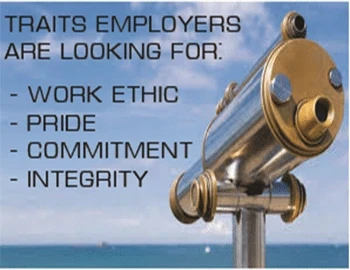
5 Traits Employers Really Seek In New Employees
When it comes to hiring employees, employers are searching for individuals that exhibit the skills and experience required to get the job done, but they also are searching for individuals that have something else.
The drive, pride, commitment and integrity to an organization that is inherent in people that have historically shown to be the highest performers within a candidate pool.
When employers see these traits within a candidate; these individuals are usually moved to the top of the stack when it comes to making a hiring decision.
So as an individual who may be searching for your next career opportunity; you may want to keep the following in mind when you are interviewing for your next job.
Drive / Hard Work Ethic
Do you learn things quickly? Have the intelligence to grasp concepts and ideas in a relevant way and focus them on the business at hand?
Understanding that experience may not be the only factor in an employer’s hiring decision, but rather they are looking for motivated employees that can do the job, are intelligent and can learn quickly.
The experience factor is important, but the understanding of the business model, your abilities to look ahead and anticipate things is of even greater importance. The drive to excel, learn and succeed is what an employer strives to find in a candidate.
Pride In The Job
Do you take pride in everything you do? Contribute to the team? Take ownership of your work? Come up with new ideas? Not make excuses?
Your job performance needs to be important to you; working hard, accomplishing tasks, striving for success and taking pride in the fact that you accomplished things is of great importance to an employer.
Demonstrating to an employer your drive, but also the pride you hold in the organization, your work and the accomplishments you have made shows a higher level of commitment as an employee that wants to do a good job and succeed.
Commitment To Organization
Are you committed to the job? Do you want to being working in this profession or are you just there for the money?
The most successful employees are the ones that truly believe they are making an impact in their chosen profession and enjoy the work that they do. Simply showing up every day and doing what is required in today job market is not going to cut it for long and you will find yourself looking for a new job rather quickly.
Candidates need to demonstrate their enjoyment for their profession and the work they are doing. Focusing on your accomplishments, ideas, and knowledge of the industry will greatly enhance an employer’s view of your commitment to the job.
Integrity
If you found a $100.00 bill on the ground; would you pick it up and put it in your pocket or try to find the person who dropped it?
Integrity is a hard thing to demonstrate in an interview setting; but integrity in daily life is easy. Holding yourself to a higher standard in your personal life, as well as, in your professional career and exhibiting that in everything you do demonstrates all the traits an employer seeks. The pride, work ethic, commitment all shine through with your integrity.
This is something you do not have to demonstrate in an interview, but it will naturally come through based on your past actions and job performance.
By keeping the above traits in mind when conducting a job search, will aid you greatly in accomplishing your goal of obtaining your next exceptional career opportunity.
Michael DeSafey is a leading executive recruiter for professionals in the construction, engineering and environmental industries. He is currently the President of Webuild Staffing (www.webuildstaffing.com). To learn more about Michael or to follow his Blog please visit www.michaeldesafey.com
How To Find And Hire The Best Employees For Your Business.

How To Find And Hire The Best Employees For Your Business.
Whether you’re a business owner, chief executive, project manager or HR Manager; you know lot a time goes into finding the right employees for your organization. The success of every business depends on the abilities of its staff and their ability to work as a team to achieve success.
One of the biggest questions many hiring managers have is: How do you find the best talent in the marketplace and how do you know which people to hire?
Do you place job advertisements? Scour through resume stacks? Interview as many people as you can? Retain recruiters? Well, the simple answer is Yes; but to hire the best talent in the industry you need to know who is working in your industry and you need to have an existing relationship with them.
Anyone can place a job advertisement and look through resume after resume until you interview and hire a candidate that best matches your requirements at that time. As a manager, though you need to build a long term outlook into your recruitment strategy. Look at your projects and/or corporate needs 1 year in advance. Determine what roles and skills your organization may potentially need and keep your eyes open for individuals with those skills. Even if you cannot hire then currently.
Simply posting job advertisements when you need to hire for a job opening will never allow you to find exceptional talent. Your job advertisement only targets individuals looking for a job at a specific point in time. Your organization always needs to be looking for high quality talent. Holding open houses, career fairs, talking with other professionals and leaders in the industry, showcasing your organization to the public.
As a manager though, you need to remember the highest quality and best talent in your industry will never actively be looking for a job. They already have one!! An employer searched them out, courted and hired them. You now need to do the same!! You need to find out who these individuals are, build relationships with them and hire them when the time is right.
You will want to attend professional association networking events, go to lunch with your competitors, talk to your clients about who they know and have experience working with, and/or search LinkedIn and other social media outlets for individuals with specific expertise and connect with them. Establishing relationships and simply take some time to get to know people, their careers, what projects they are working on, what motivates them, and where they see their career going, etc. will allow you as a manager when the time is right to select and make the right strategic hire quickly and efficiently.
But they may not be looking for a job?? Wrong!! You will be surprised how open people are about learning about a new career opportunity when approached. 90% of the currently employed workers will never turn down a potential new opportunity. Everyone is always looking for something better!! By having an existing relationship with them, the courting process is much more efficient, effective and beneficial to the organization doing the hiring.
You already know what makes the candidate tick, what they enjoy, where their expertise is, the type of personality they have, etc.. The relationship is already established all you need to do now is reel them in and make sure the position you have matches their desires, salary and career advancement needs.
Managers that are always building relationships and keeping their eyes open for exceptional talent in the course of their daily business activities will never find themselves lacking exceptional talent for a growing organization. Their businesses will be thriving, while others are still posting job ads and interviewing candidates.
Michael DeSafey is a leading executive recruiter for professionals in the construction, engineering and environmental industries. He is currently the President of Webuild Staffing (www.webuildstaffing.com ). To learn more about Michael or Follow his Blog please visit www.michaeldesafey.com
Ways To Increase Your Employees Morale – Free!!

Ways To Increase Your Employees Morale – Free!!
As a professional recruiter who has been working and recruiting professionals in the environmental, engineering and construction industries for over 18 years now at Webuild Staffing, I have talked with many managers who find it hard to motivate employees.
As a manager you have the responsibly to manager your employees, motivate them and keep the morale of the office high. Studies have shown the companies that have high level of morale prosper significantly greater than low morale organizations.
Historically, larger companies have offered bonuses, trips, prizes to keep performance and morale high, but if your organization does not have the budgets or capacity to offer those types of morale boosters. Here are a few tips to improve morale without taking a bite out of the budget.
Genuinely Show You Care About Your Employees…
For most employees that office is their second home. They spend a significant amount of time every day at the office, but it is their second home. They have families, interests, activities that matter to them outside of the workplace. So showing an employee that you care is one of the easiest ways to reward them. Allowing an employee to take care of their family life is one of the greatest rewards you can give an employee. Let them take a day off, send them home early, if they need to take care of a personal issue during working hours; let them do it. Having an employee whose family is happy will go a long ways in boosting company morale. The employee will be more productive, care about the company greater and encouraged to work harder.
Recognize Employees For Their Hard Work..
When you hire an employee you expect them to work hard and do a good job. But when someone goes above and beyond expectations and works hard to help the company. Employers need to recognize it; which could be anything from offering a simple thank you or an employee of the week recognition to a plaque for exceptional performance.
Most individuals value personal recognition over anything else in the workplace. If they know they are being acknowledged for their hard work, they only need simple recognition to keep their morale high.
Focus On Achieving A Goal ..
Companies have a strategic direction, goals they are trying to achieve. Employees work to achieve those goals every day, but reminding an employee about the good they are doing, the people they are helping, how the company benefits a wide variety of customers and/or people lives are positive reinforcement for employees to do a good job. If they can relate to their customers, see the impact their products, services are having on the community as a whole. Morale within the company will jump greatly.
If customers recognize an employee’s hard work, let the employee know about it. If a product or services impacts a specific customer in a life changing way, let the employee know their work greatly influenced that person’s life. If an employee recognizes their hard work is paying off, morale will jump greatly throughout an organization faster than any other reward that can be offered.
The above tips are only a few of the many ways in which you can reward an employee and keep company morale high, without affecting the company’s overall budget.
Michael DeSafey is a leading executive recruiter for professionals in the construction, engineering and environmental industries. He is currently the President of Webuild Staffing (www.webuildstaffing.com). To learn more about Michael or Follow his Blog please visit www.michaeldesafey.com
